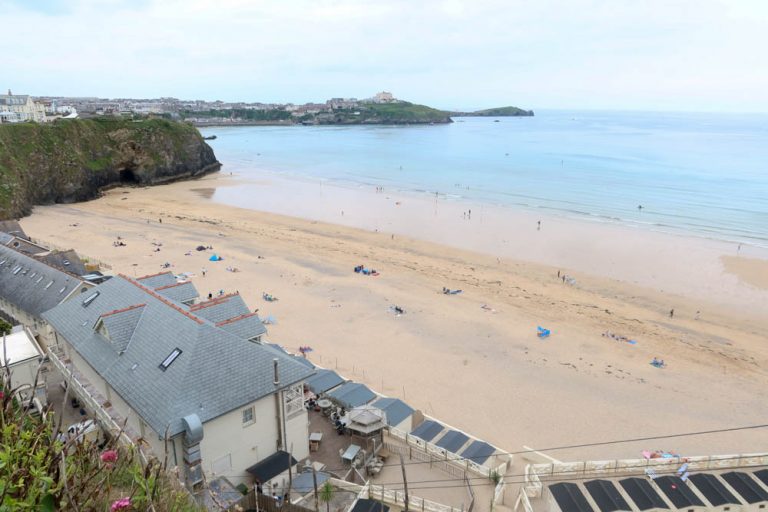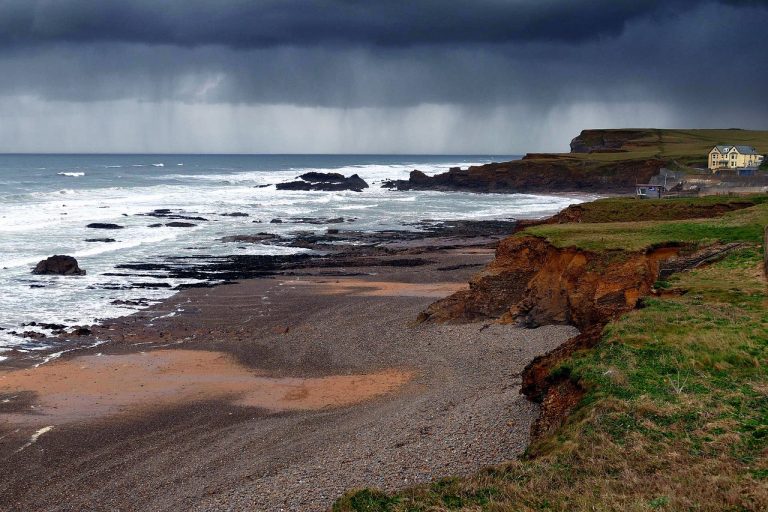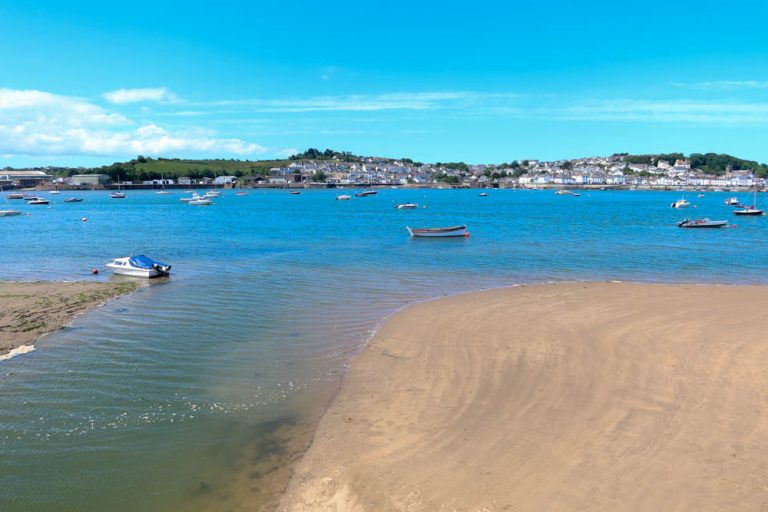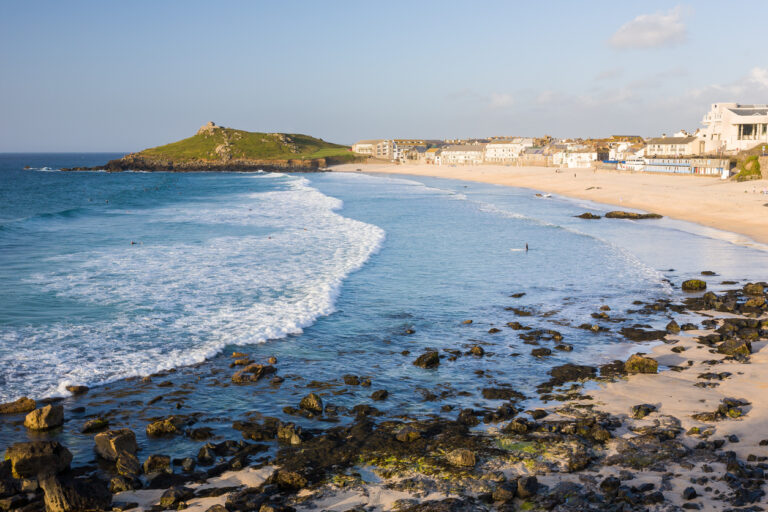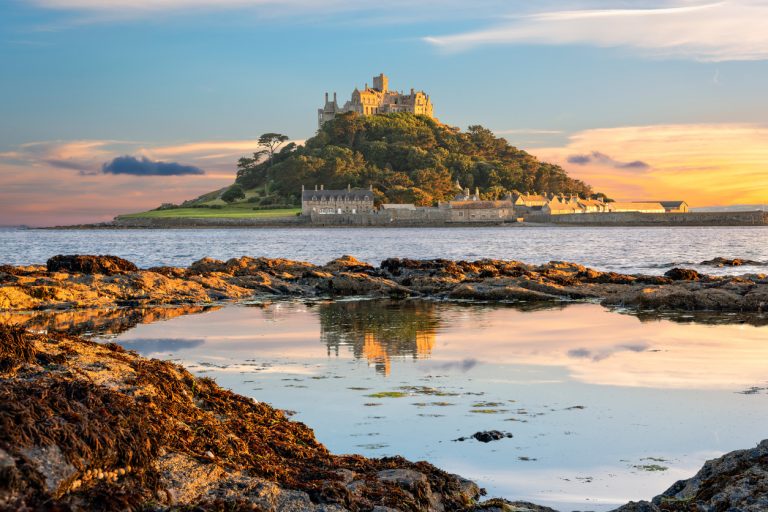72 best things to do in Cornwall: local 2024 guide!
Are you looking for the best things to do in Cornwall? You’re in luck – I know the area like the back of my hand and love showing the top Cornish attractions!
There’s nothing I love more than showing off my beautiful Cornwall.
It’s often voted the most beautiful place in the UK, famous for its golden beaches that wouldn’t look out of place in the Mediterranean.
The hiking trails are world-class, with a dramatic coastline and the sweeping Bodmin Moor right in the centre.
However, some of the best things to do in Cornwall are engaging in its cultural activities.
The region has a distinctly different culture and history to the rest of England; it’s one of the Celtic Nations, which means that there’s plenty to learn about, unique festivals, curious museums and even a whole other language to learn if you fancy it!
I come from a very long line of Cornish ancestors (I’ve traced my family history back to the 13th century), and I’ve spent a great deal of my life exploring Cornwall.

Nowadays, I live just 50 miles from the border in Devon, so I’m frequently popping over for mini-trips to see my family or revisit some of my favourite tourist attractions.
I’ve not only seen all of the primary tourist sites but encountered hundreds of local places that most tourists don’t know about too.
And I’ve put them all together in this post!
This post boasts the Cornwall highlights (like Fistral Beach, the Eden Project, St Michael’s Mount and the Minack Theatre) while you’re here, but read on for plenty of tips for my other favourite local spots in Cornwall too.
So let’s look at the best things to do in Cornwall!
This blog post may contain affiliate links
Best things to do in Cornwall: My top 10
After spending my whole life visiting Cornwall, and exploring many of these attractions time and time again, along with my local knowledge, here are my favourite things to do in Cornwall.
- the rocky ruins of Tintagel Castle
- Coastal views of Land’s End
- walking around the picturesque Mousehole
- eating all the food and soaking in the vibe of Falmouth
- hiking in the Lizard Peninsula
- surfing at Fistral Beach or Bude
- lazing on the beach at Carbis Bay
- exploring the wilds of Bodmin Moor
- learning Tudor history at Pendennis Castle
72 top attractions and activities in Cornwall
Laze on beaches that extend for miles, surf in the Atlantic Ocean, retreat into some of the country’s best museums – Cornwall has it all. Finish your day by indulging on including Cornish pasties and fresh seafood and spend the night in one of the region’s best hotels. There are so many incredible things to do in Cornwall – let’s dive in!
1. See flora from around the globe at the Eden Project
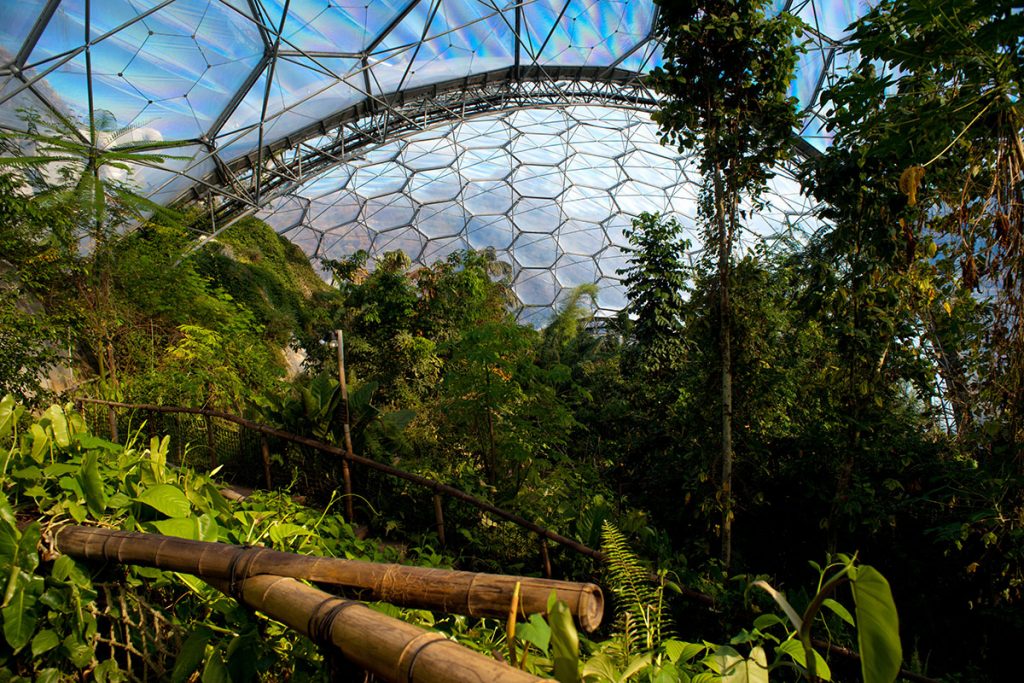
The Eden Project is certainly one of the most-visited attractions in Cornwall.
Popular with families due to its child-friendly exhibits, it’s also fascinating for adults – where else can you walk around a jungle in the UK?
With two large biomes, one home to rainforest flora and one with Mediterranean plants, the Eden Project offers guests an immersive experience where they can learn about different landscapes and climates across the world.
In a time when preserving natural climates is becoming increasingly important, The Eden Project offers a valuable snapshot into conservation and restoration.
The biomes, which detail all of the different plants that are included in the displays, are the primary attraction, but there is also a zip wire, a 360 swing, and a small bungee jump.
I’ve visited the Eden Project as a child, a teenager and an adult, and can attest that I’ve enjoyed it whatever my age!
2. Go back to the Tudor era at Pendennis Castle
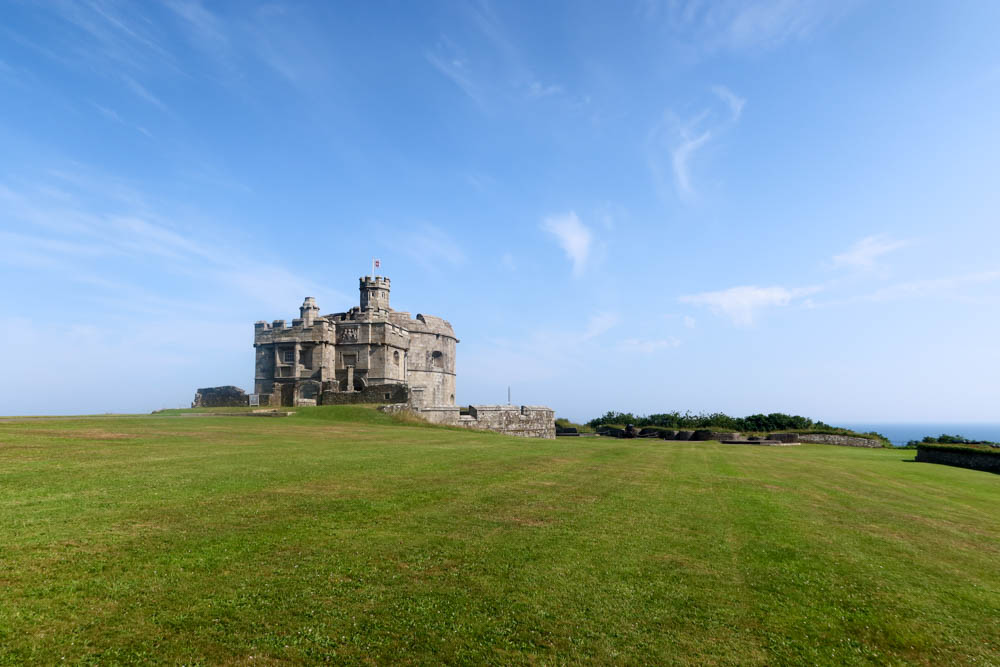
Probably my favourite castle in Cornwall, this fortification, located near Falmouth, was created during the Tudor era to defend Cornwall from naval attackers.
It also played an essential part in keeping this part of the country safe during both World Wars.
Visitors can marvel at the historic castle and learn how it has been used as a defensive structure throughout the centuries.
Pendennis Castle also boasts incredible views over the Fal Estuary and temporary exhibitions in the rooms above the shop and cafe.
When I was last there, there was an interesting exhibition about conscription and British troops in World War One (Falmouth had a military training site).
3. Learn about Naval History at the National Maritime Museum Cornwall
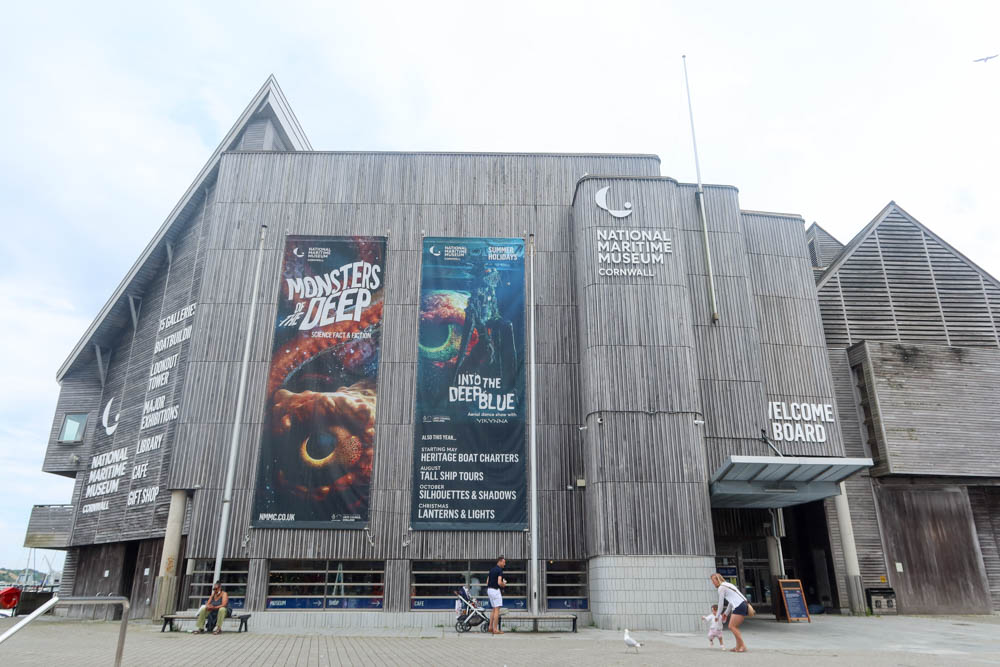
The National Maritime Museum Cornwall is definitely one of the best things to do in Falmouth.
It’s an exploration of everything related to the sea around Cornwall.
As Cornwall is very nearly an island (if it wasn’t for those six miles between the source of the Tamar and the North Coast…), life in the region has always largely revolved around the sea.
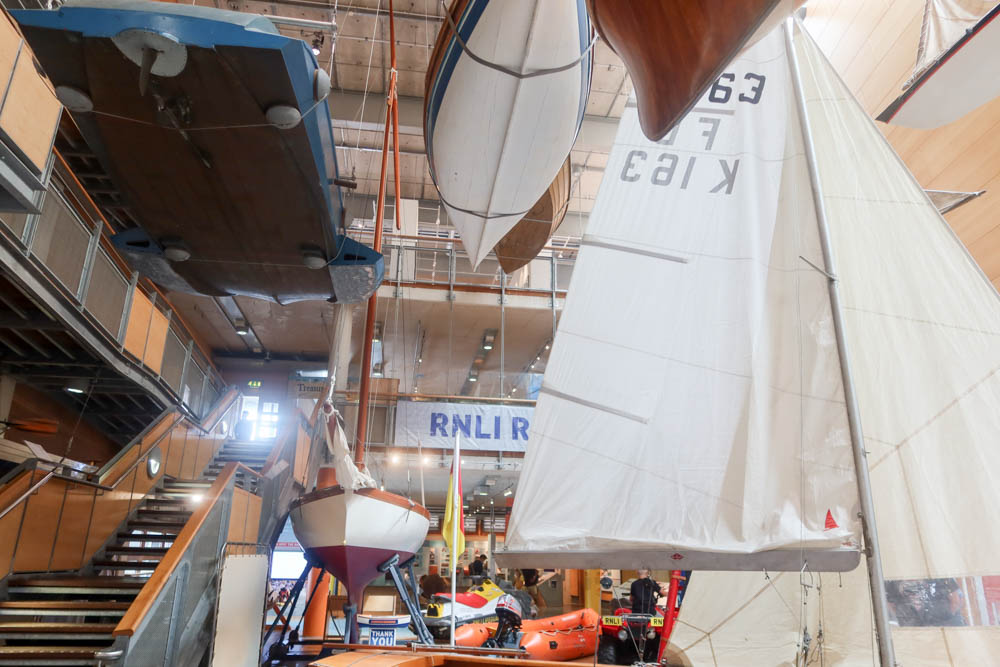
Take a look at boats from throughout the ages and learn about their unique stories, uncover the fishing industry and, in more local news, discover the fascinating tales of the Falmouth Packet and how it connected the world.
As a side attraction, I recommend the Falmouth Uncovered Walking Tour. I’ve done quite a few walking tours in Cornwall and this was my favourite.
If you’re keen on learning the history of how Falmouth originated and how the Falmouth Packet made the town incredibly different to the rest of Cornwall then definitely check it out!
4. Gorge on Falmouth’s amazing street food
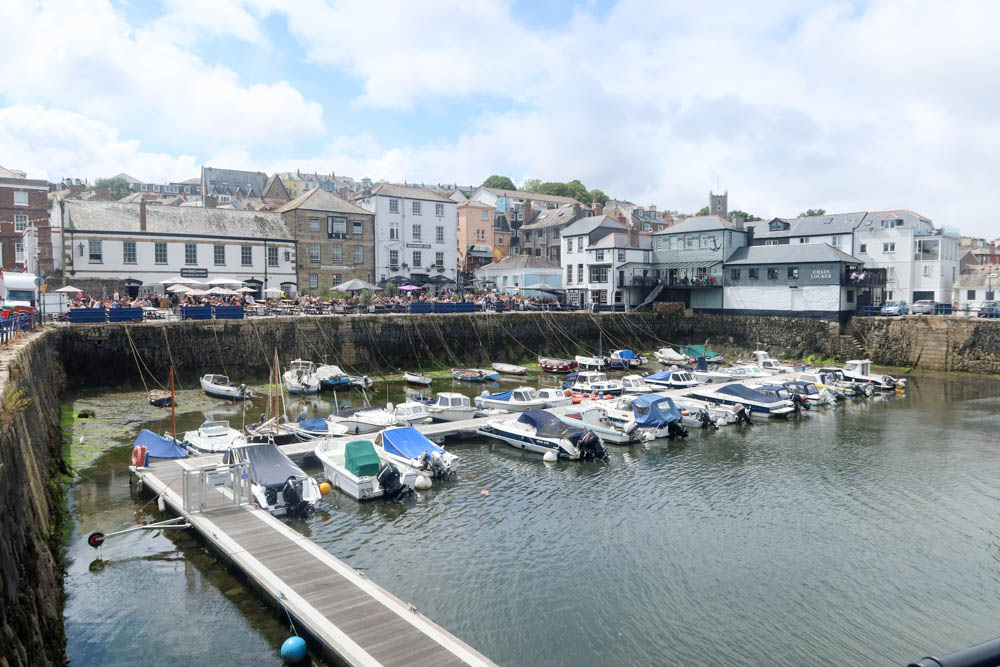
While Padstow is often considered to be the best foodie destination in Cornwall, Falmouth is my favourite.
From pasties with unique fillings to steaming hot bowls of ramen, Falmouth has always been somewhere where different cultures have met (thanks to the Falmouth Packet – you’ll need to go on the walking tour to learn all about it!) and merged throughout the centuries.
And nowadays, you can experience this through Falmouth’s food! In fact, it’s my favourite place to stay in Cornwall just because of the immense amount of culinary options.
5. See St Mawes Castle, Pendennis’s little sister
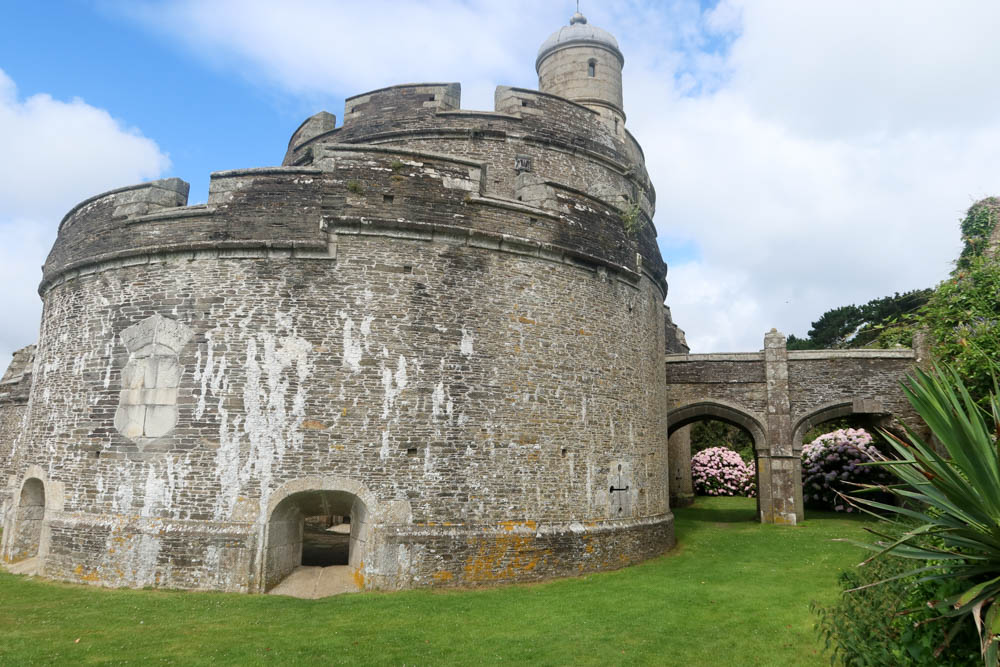
St Mawes Castle sits just opposite Pendennis, on the other side of the Fal Estuary.
Also dating back to the Tudor period, St Mawes Castle is much smaller than Pendennis.
It’s quite a lot smaller, but you’ll find beautiful views over Carrick Roads along with Latin Inscriptions dedicated to Henry and Edward VI.
You can get to St Mawes from Falmouth by boat; strolling around St Mawes village is also pleasant!
6. Get lost in the Gardens of Heligan
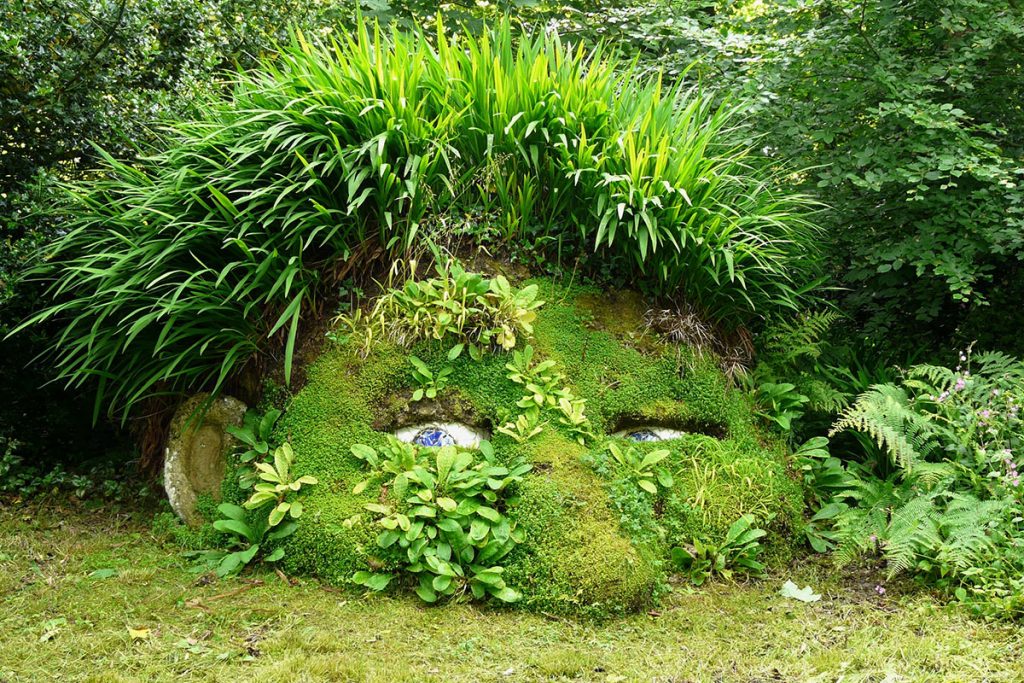
Fancy heading down to tropical gardens – with an incredible story – while you’re in Cornwall?
One of the most fascinating attractions in Cornwall, the Lost Gardens of Heligan, located near Mevagissey, got their name from the fact that they were literally lost after World War One, and were found again after the 1990s.
Originally part of the Heligan Estate, which is somewhere I’ve traced my family ancestry back to (official documents state that John Tremayne, who once owned the Heligan estate, was my eighth great grandfather – although for various reasons we don’t think that the dates match up!), these gardens sprawl over 200 acres.
Enjoy the kitchen gardens, the Lost Valley with a 30 metre rope bridge and tropical plants, interesting statues, a gorgeous walled flower garden and farm animals.
7. Walk from Rame Head to Cawsand and Kingsand
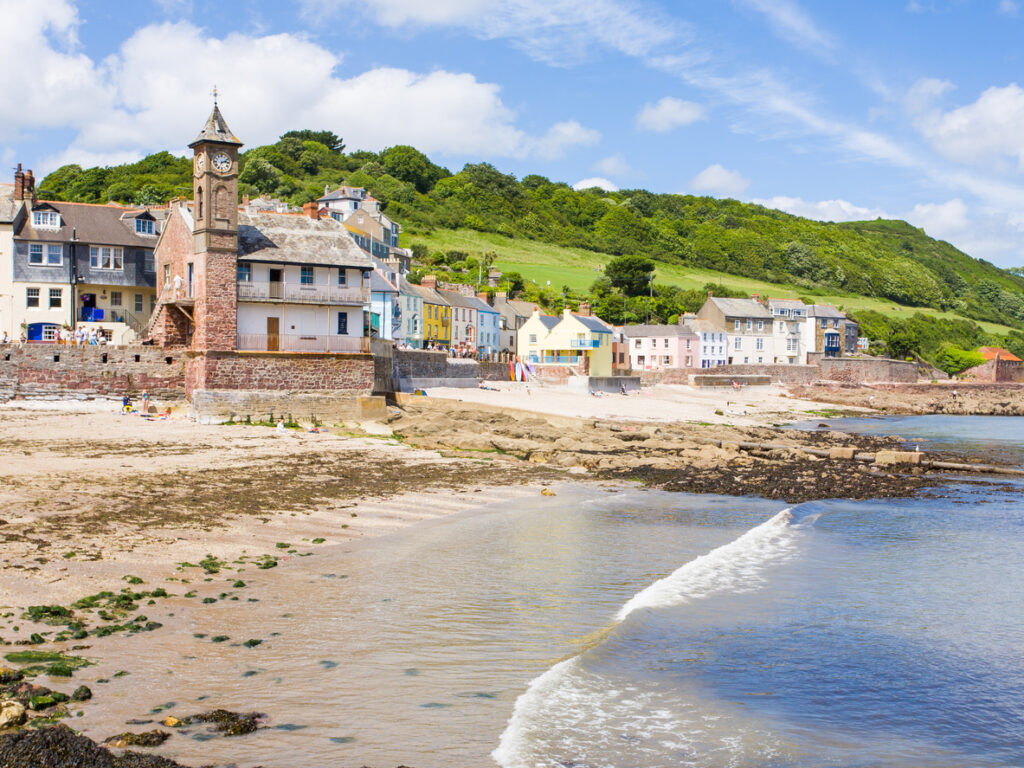
If you’re looking for hidden gems in Cornwall, you absolutely have to visit the Rame Peninsula.
Sitting just west of Plymouth, the other side of the Tamar Estuary, this peninsula is known as “forgotten Cornwall” because it’s remote and difficult to access.
However, this just means that it’s not overrun with tourists, like other areas of Cornwall, and the landscapes are just as beautiful.
Park up at Rame Head, landmarked by the rocky Rame Head chapel and with views out to the tumultuous ocean.
Last time we visited, we took the South West Coast Path from Rame Head, walking along the peninsula towards the twin villages of Cawsand and Kingsand.
There are a few pubs and restaurants across the two villages; I love The Bay which looks out onto Cawsand Beach.
We refuelled here before hiking back to Rame Head.
It was a lovely coastal trek and and an excellent way to see one of Cornwall’s best local spots.
8. Cruise on the Fowey Estuary
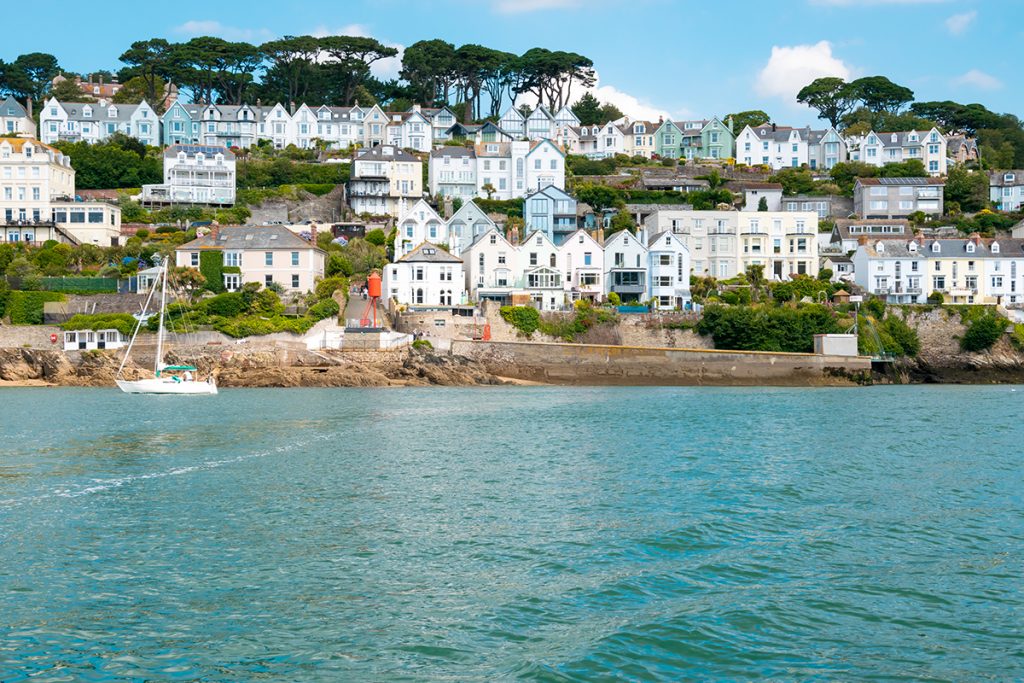
Fowey is a beautiful medieval town sitting on the south coast of Cornwall.
By taking a boat trip from the town, you’ll explore the Fowey Estuary, an AONB, and learn about the heritage of the coastline. Plus, you’ll see Daphne Du Maurier’s old house, Menabilly.
My grandad was the policeman of Fowey when Daphne Du Maurier lived there.
He used to like popping to Menabilly because the cook would always make him a delicious sandwich!
You can book boat trips from the kiosk by the harbour. More information here.
And here are the rest of the best things to do in Fowey!
9. Hike to Lantic Bay

Lantic Bay is a cove sitting at the bottom of the cliffs; this beach is one of the best hidden gems in Cornwall.
Lantic Bay is landmarked by tall cliffs and white sand – and thanks to its bright blue water, you’ll feel like you’re in the Mediterranean rather than on a British beach!
Lantic Bay is quite difficult to access, which makes it one of the quieter beaches in Cornwall. I’d recommend hiking from Polruan to Polperro and stopping at Lantic Bay on the way!
10. Explore the quaint Charlestown Harbour

Charlestown Harbour is one of the most beautiful places in Cornwall, and you should definitely add exploring this unique village to your Cornwall itinerary.
Historically a fishing village called Porth Meur, the port at Charlestown was built by Charles Rashleigh in 1791.
It’s changed very little since this time, and the fact that it’s so perfectly well preserved has given it world heritage status and means that it’s the setting for a lot of movies filmed in Cornwall!
Either go on a walking tour around the village to learn about its history – I did this walking tour with a Charlestown local before, which was very in-depth but interesting and an excellent way to understand the village!
It’s also worth visiting the Shipwreck Treasure Museum, which details the history of shipwrecks along the Cornish coastline.
See all things to do in Charlestown here.
11. Take a boat trip to Looe Island
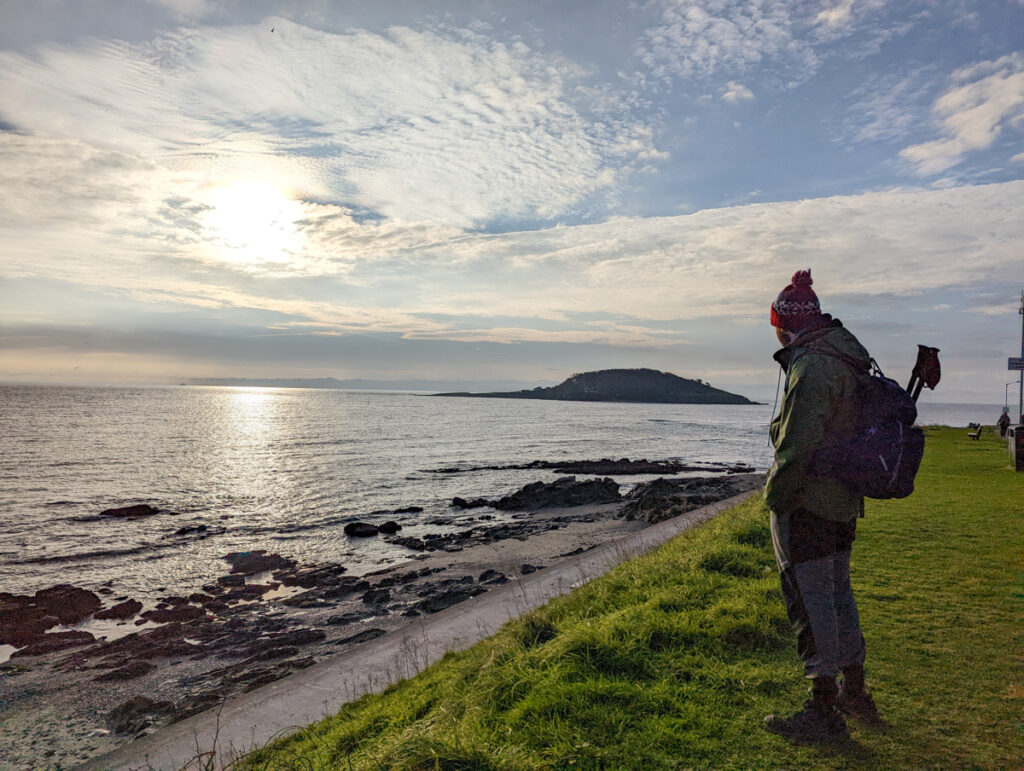
Looe Island sits off the south coast of Cornwall and is a short jaunt from the town of Looe.
You can explore the island by going on a nature walk; these leave from town and include the ferry over along with a guided tour about the island and its unique flora and fauna.
Or, you can stay on Looe Island. This is an off-grid adventure and an incredible chance to take in this island’s nature at a slow pace.
12. Learn about smuggling history at Polperro

A charming village sitting in a rocky cove, Polperro enchants most travellers who stumble upon it.
While it’s nowadays one of the most beautiful seaside villages in the Duchy, Polperro was once a smuggler’s haven.
You can learn all about this by walking around the laneways of The Warren, which run back from the cliffs to the east of the village.
Another way to take in this history is by visiting the town’s museum, which is based on smuggling and fishing, and how life has revolved around the water for centuries.
When you’re finished in the museum, take some time to walk around the village; it’s one of my favourites!
13. Walk the Tamar valley trail
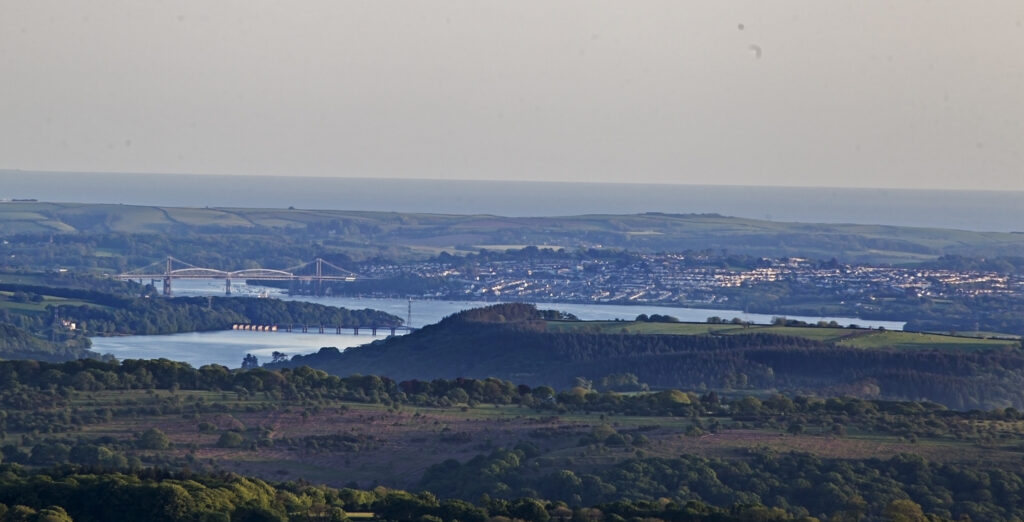
The Tamar Valley Trail leads along the southern part of the River Tamar.
This trail is nowhere near as popular as the South West Coast Path or other popular hikes in Cornwall, but it’s well worth the visit.
Traversing from Plymouth’s northern boundaries to Launceston, the Tamar Valley trail journeys through temperate rainforest and along stunning riverside scenery.
I’d recommend doing the Gunnislake to Calstock walk. You can walk one way (there’s parking at Gunnislake station) and get the train back, but check train times before heading out as they only run once per hour.
On this walk, you’ll see the beautiful Calstock Viaduct and, if you have time, I recommend enjoying a cream tea at The Tamar Inn.
Don’t forget to put the jam on your scone first – you’re in Cornwall after all!
14. Go surfing on Fistral Beach
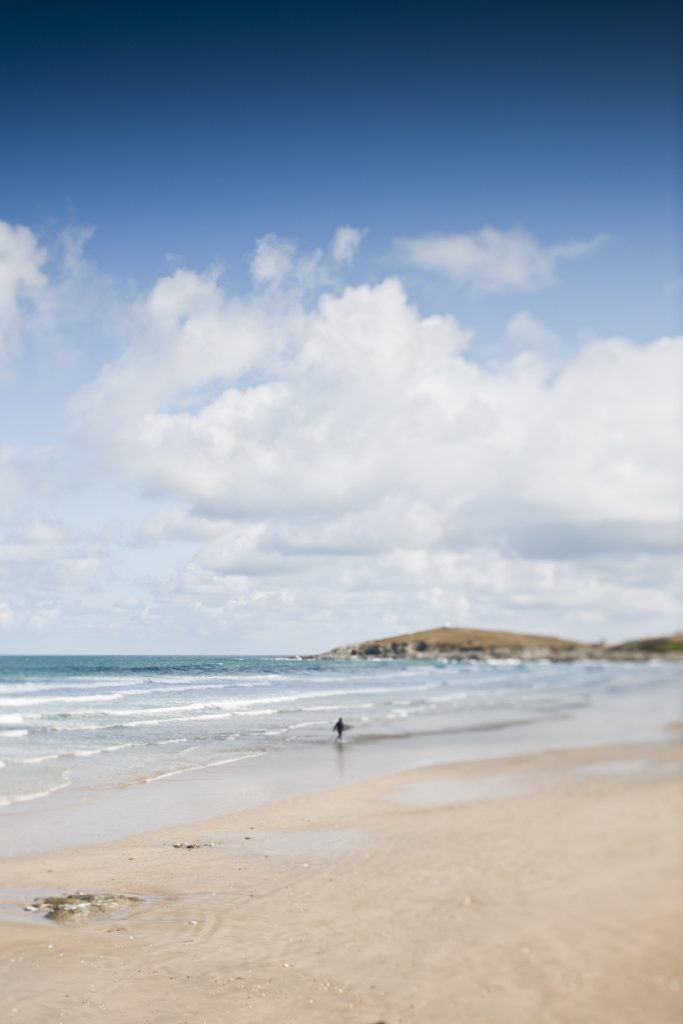
Perhaps the best surfing spot in the country, due to its mild weather and huge waves, Fistral Beach in Newquay has been dubbed ‘Little Australia’.
It’s a great place to take to the waves, but be warned – for inexperienced surfers, these waves can be treacherous.
However, there are plenty of surfing schools offering individual or group lessons.
15. Snap some photos of Bedruthan Steps
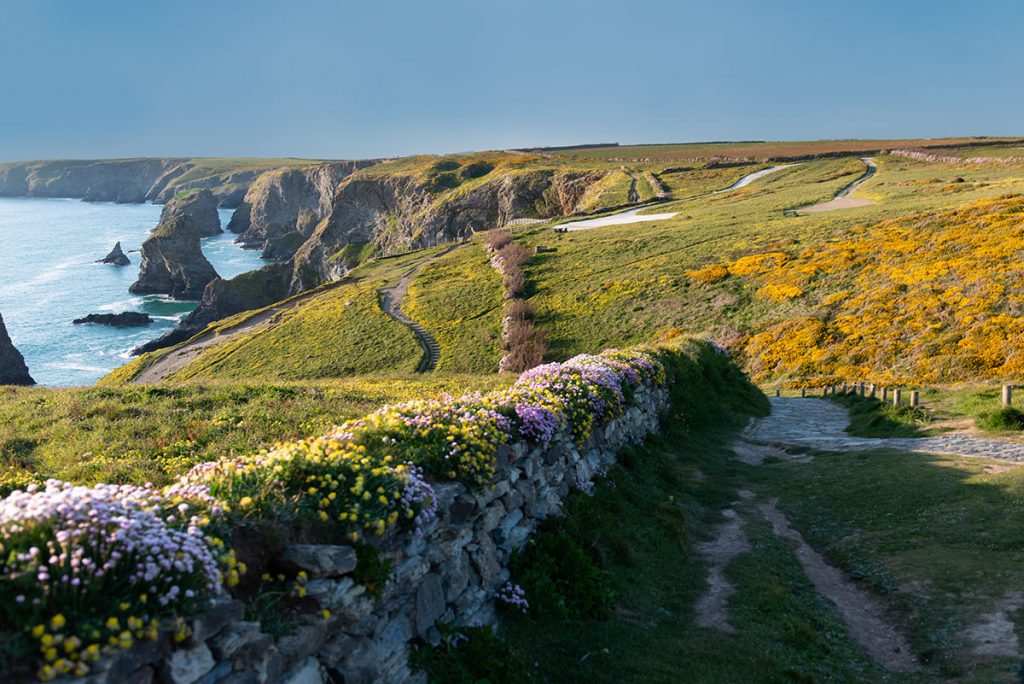
Just along the coast from Newquay are the iconic Bedruthan Steps, among the most beautiful places to visit in Cornwall.
Jutting out into the gorgeous blue ocean, Bedruthan Steps are striking land masses that look like they’re straight off a postcard from the Med.
There are (actual) steps that can take you down to the beach, but these are currently closed. If they reopen, they will lead to a tiny beach and cave area.
But Bedruthan Steps are best enjoyed from above; you can walk along the cliffs and marvel at the view at no cost and without too much exertion!
If you’re driving along the North Cornish coast, it’s a must-do.
There’s also a beautiful hotel (Bedruthan Hotel and Spa) and cliffside retreat sitting at the top of the cliffs, with epic views over the ocean.
16. Do a Doc Martin Tour in Port Isaac
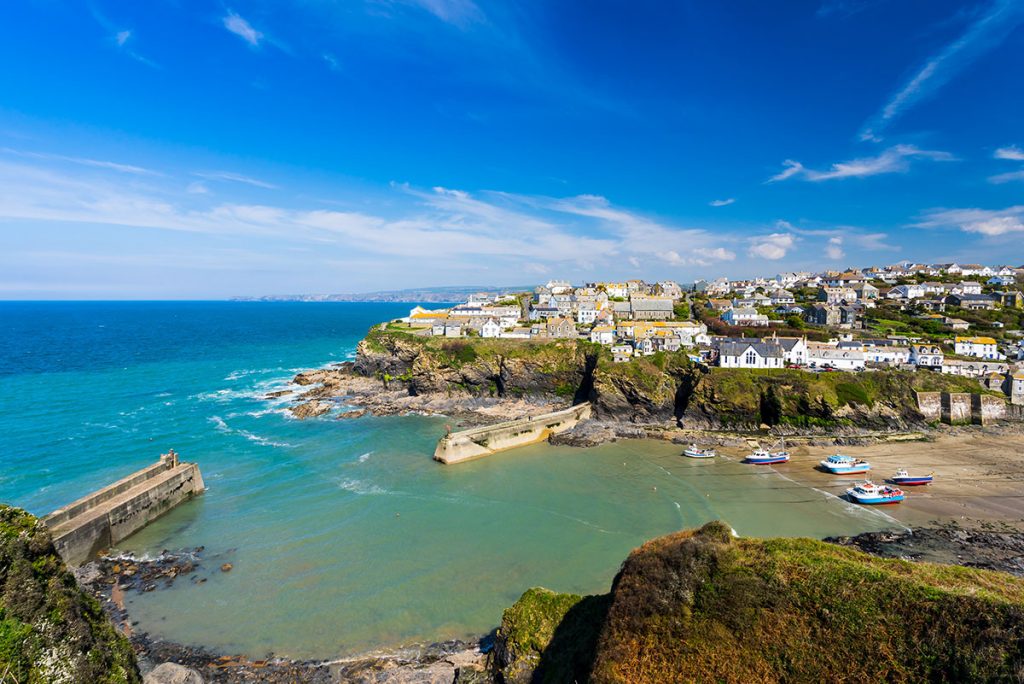
Famous for being the village Portwenn in Doc Martin, this sleepy little seaside village is a great place to experience Cornish rural life.
You can do a Doc Martin tour around the streets of the town; the guide will show you around the main filming locations of the town and give you some insider information about its production.
It’s definitely one of the best things to do in Port Isaac!
The village has steep, narrow streets – it’s best to leave your car in the car parks outside – and granite houses; the streets eventually give way to the sea.
The beach is the most renowned attraction in Port Isaac, with plenty going on – fishing boats are constantly coming in and out, and many of the best restaurants are seafront – but the village is excellent for a stroll around as well.
17. Walk around Boscastle Harbour

Ran by the National Trust, Boscastle is home to a cove and a harbour and is also an essential visit for any fans of the weird and wonderful.
One of the best things to do in Boscastle is to explore its links to the supernatural, and one of the best places to learn about that is the Museum of Witchcraft and Magic and the small Minister Church, which is home to the grave of a white witch.
There are also natural phenomena around Boscastle, including the Devil’s Blowhole and the Coastguard Lookout.
Boat tours also go around the cove. Its array of attractions certainly makes visiting the village one of the best things to do in Cornwall.
18. Experience Cornwall’s mythology at Tintagel Castle
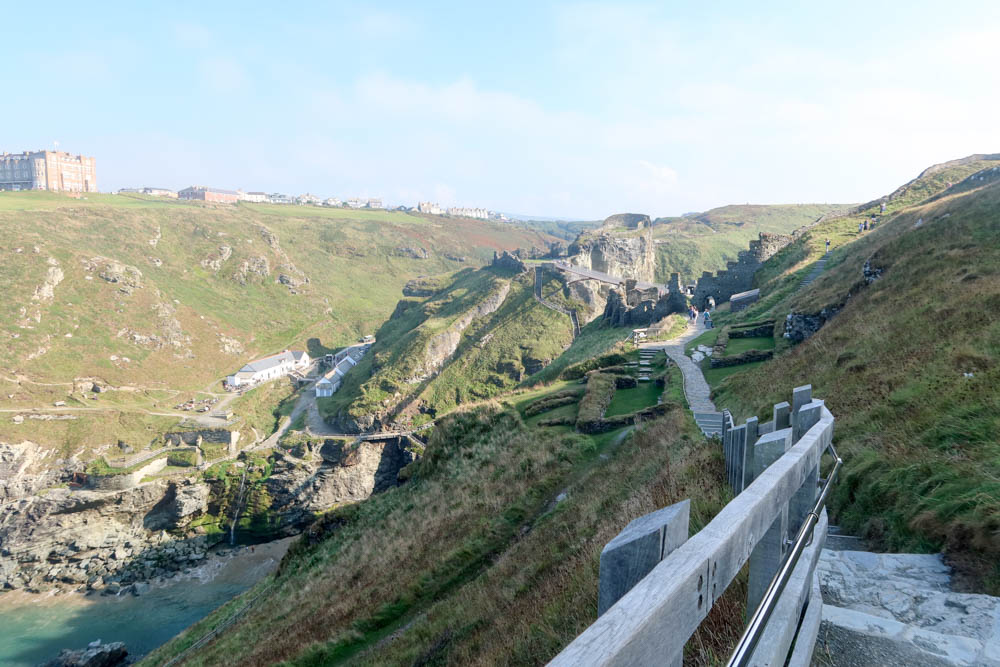
Standing high on a clifftop on the North Cornish coast, the ancient castle of Tintagel has links with the legend of King Arthur and is set in two parts, which has been linked recently by a bridge.
There has been a defensive castle on site since the 13th century, but it was a Roman military outpost and a place of residence for Cornish kings.
There have been some fascinating discoveries in the castle, including Andalusian pottery and Mediterranean wares.
Once you’ve explored the castle, don’t forget to see Tintagel’s other attractions!
19. Enjoy the food scene of Padstow
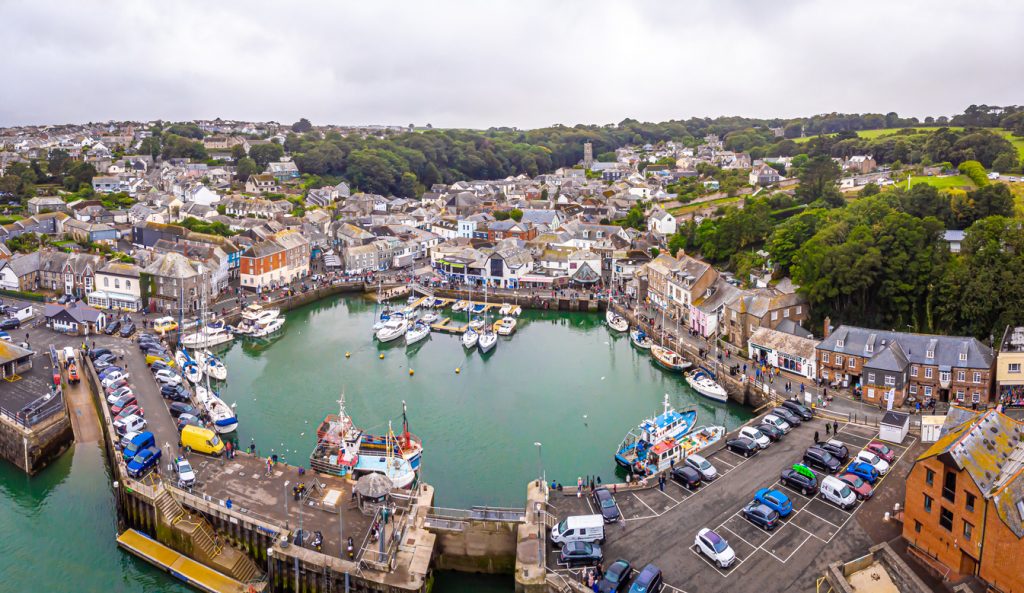
The harbour town of Padstow is a beautiful spot; I love taking in panoramic views of it from vantage points around the town.
However, Padstow is most famous for its foodie scene. It’s certainly worth visiting if you’re into fine dining experiences; celebrity chefs Rick Stein and Paul Ainsworth both have multiple restaurants here.
I have only eaten at Paul Ainsworth’s Italian, Caffe Rojano, which was decent (albeit a little overpriced!).
However, if you’re into seafood or want a lavish culinary experience, Padstow’s pretty famous for it.
20. Sample some gin at the Tarquin’s Gin Distillery
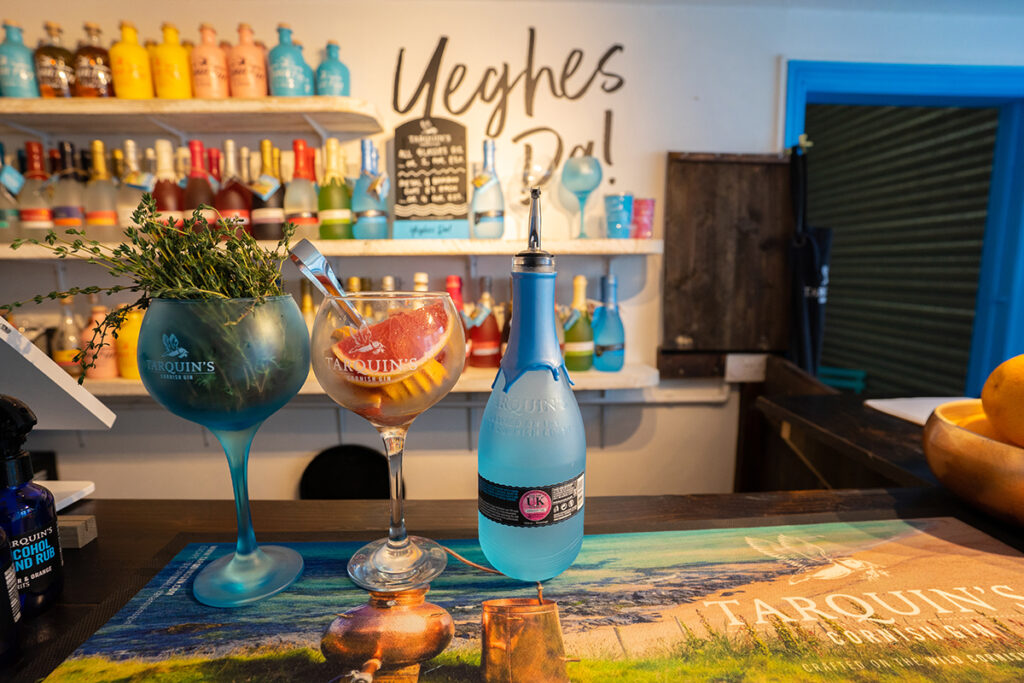
I only stumbled upon Tarquin’s Gin Distillery on one of my trips to Cornwall last year; and I’m so glad I did.
This boutique gin-making workshop is run by a Cornish local named Tarquin (hence the name). It’s not a huge operation by any means; the boutique distillery is located in a small garage-like structure halfway between Padstow and Wadebridge.
However, the inside has been decorated marvellously; and gin tours and tasting experiences run a few times a week.
21. Hike into Cornwall from Hartland Quay
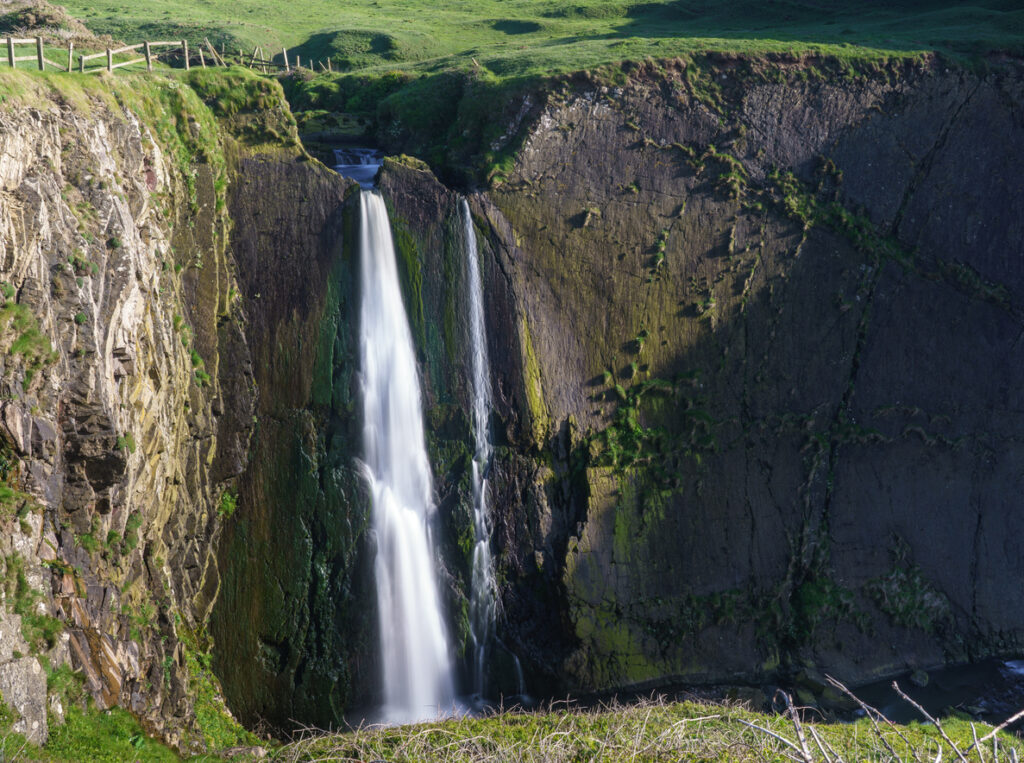
When you drive to Cornwall, you’ll either go past the “nearly there trees”, which is a small copse of trees by the A38, or the Tamar Bridge which spans the River Tamar by Plymouth.
If you hike into Cornwall, the entry is a little more nondescript, with a small wooden sign welcoming you to Cornwall, or Kernow, which is what we call it here!
You can hike into Cornwall by completing the Hartland Quay to Bude section of the South West Coast Path.
This is the most difficult coastal path section that I’ve done (I’ve hiked all of Cornwall and I’ve nearly completed the whole thing!); but it’s tremendously rewarding and perfect if you want to go somewhere with virtually zero crowds.
You can read my full guide to this hike here.
22. Climb down to the unique Towan beach in Newquay

There are a lot of epic beaches in Newquay, but Towan Beach is one of my favourites.
It’s an excellent one to photograph, thanks to its rocky island which is connected to the mainland by a bridge.
The rocky island has a house on top, which can now be rented as a holiday home.
It’s certainly one of the most unique places to visit in Cornwall!
23. Take in the sunset from Wheal Coates
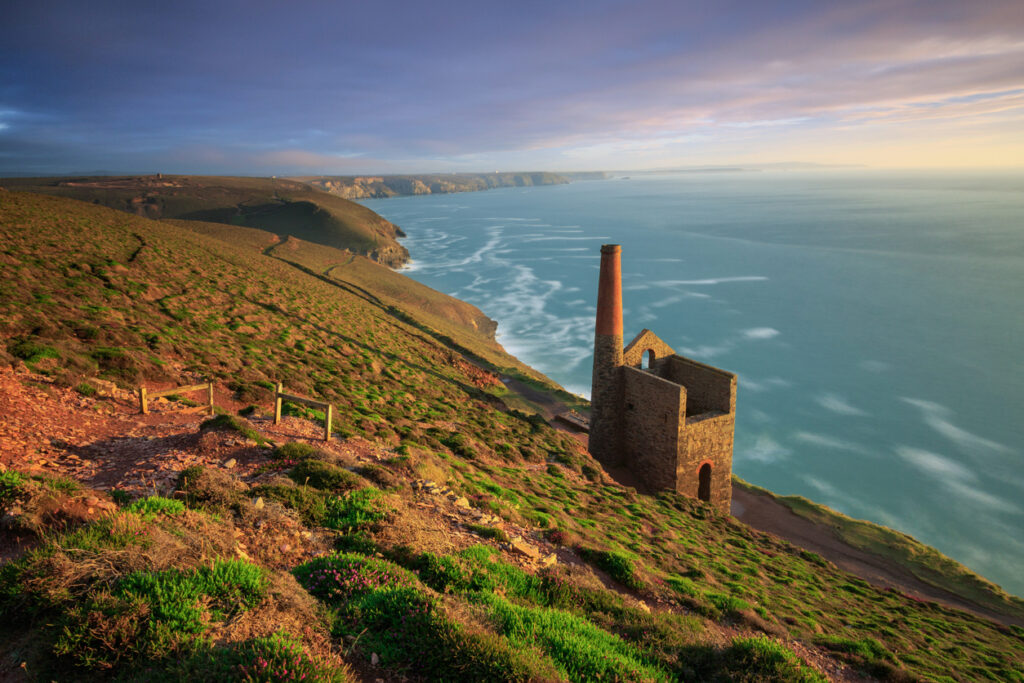
Sitting just back from the coastal path, Wheal Coates is the ruin of a tin and copper mine near the small village of St Agnes and in the heart of the mining coastal bath.
Dating back to 1802, Wheal Coates sits amongst gorse and heather bushes.
From a vantage point on the path, you can take an excellent photo of the ruins with the cliffs in the background. In fact, it’s one of the most photographed places in Cornwall.
24. Drink some cider at Healey’s Cornish Cyder Farm
Healey’s Cornish Cyder Farm is located close to Perranporth and Truro, and is where Rattler’s, the iconic Cornish cider, is created.
You’ll find Rattler’s on tap in most pubs in the Duchy (or you can buy bottles in the supermarket!), but it’s well worth checking out!
Enjoy the cider museum, go underground in the whisky cellar, say hello to the farm animals, do tastings or have a traditional cream tea (with a cider on-side!) in the cafe.
We did a gin experience there once, which was really interesting; they make gin out of apple peels and all experiences include a tasting. You can read more about them here.
25. Or try some wine at Trevibban Mill Vineyard
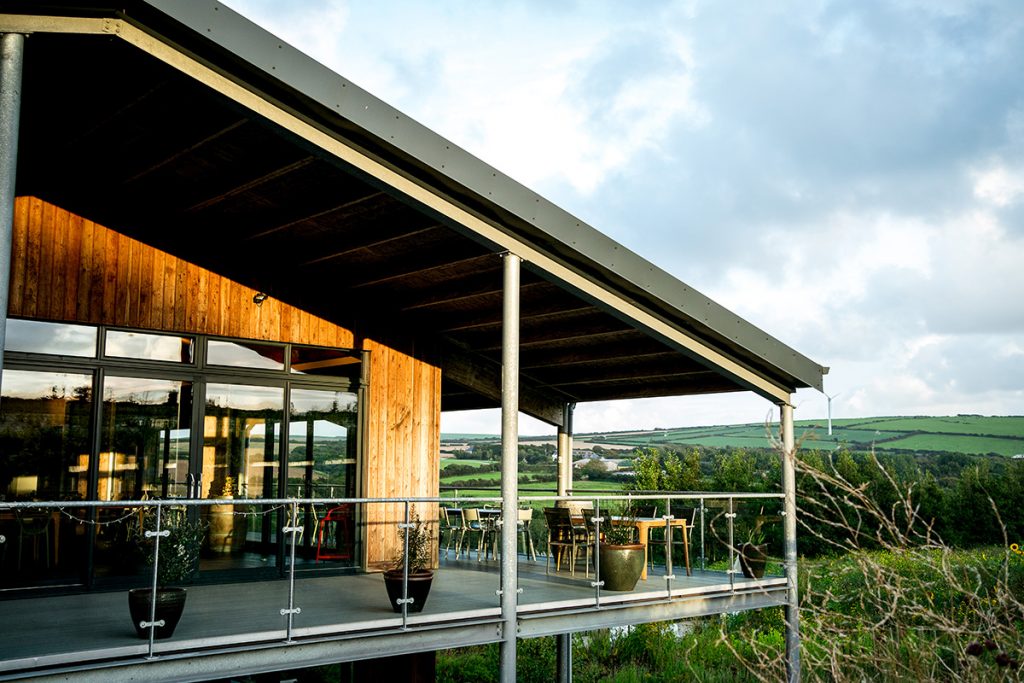
There are a few wineries in Cornwall, and the Trevibban Mill Vineyard is one of my favourites.
Located near Padstow, this winery is just as extensive as any that you’ll see in France and Spain.
They create red, white and rose wines from their vast estate and serve them up in their bar and shop.
You can do guided tours around the whole vineyard, walking tours around the estates or tastings in the bar.
Click here to read more about it.
26. Cycle the Camel Trail
The Camel Trail spans inland from Padstow to Bodmin. It’s an easy cycle route, with tranquil riverside scenery, and its the perfect way to take in some gorgeous Cornish countryside scenery.
You can hire bikes from Camel Trail Cycle Hire.
27. Head out to St Michael’s Mount island
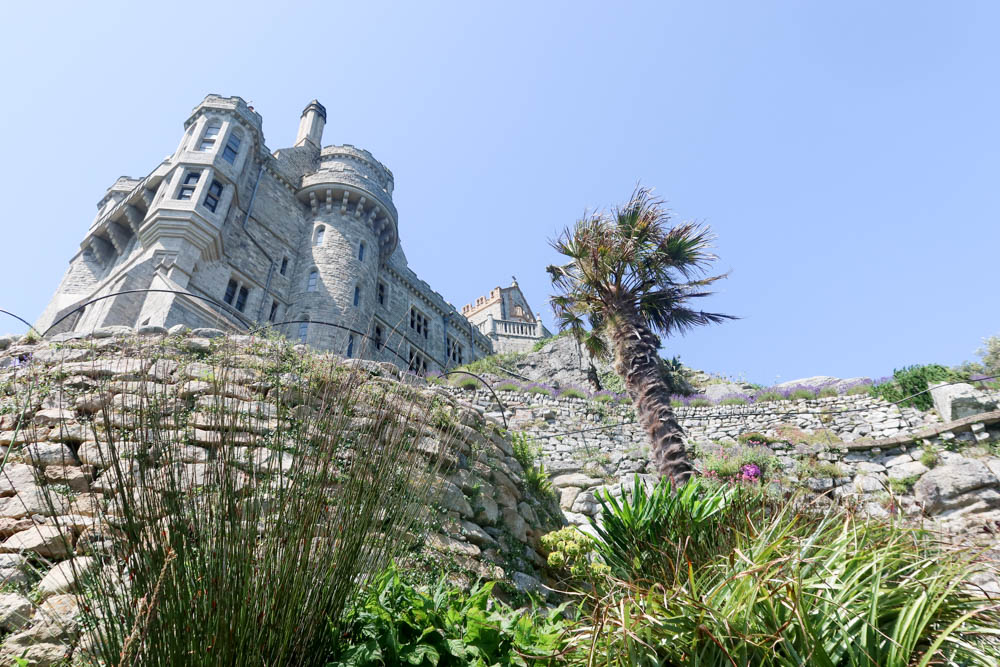
Jutting out into the sea at Mounts Bay is St Micheal’s Mount, an island with a medieval castle and church built upon it.
It’s one of the most popular things to do in Cornwall due to its mystical appearance. It was thought to be a sacred place since 495 AD, and four miracles are meant to have happened between 1262 and 1263.
The castle was built around the Norman conquest time, and it is steeped in legends and history.
The most famous of these is perhaps the legend of Jack the Giant Killer, a brave Cornish lad who defeated a giant who had taken up residence there.
Nowadays, you can visit to enjoy the gardens and walk around the historical rooms of the castle. Depending on the tide times, you’ll need to either walk over on the causeway or take a boat. Expect gorgeous views over Mount’s Bay, interesting history and a range of plants in the terraced gardens!
28. Catch a show (or look around) The Minack Theatre

The Minack Theatre is set outdoors, on the clifftop of a rocky outcrop. Its subtropical gardens are the perfect place for a wander, but the main attraction is the glorious theatre itself, overlooking Porthcurno Bay.
It was created by Rowena Cade in the 1930s up until she was in her eighties.
Although it was still being constructed, the theater has shown productions from the 1930s onwards.
You can either visit the theatre to walk around and explore, or even see a play – shows are exhibited at the theater from May to September every summer. We saw The 39 Steps last summer and loved it!
29. Paddleboard on Stithians Lake
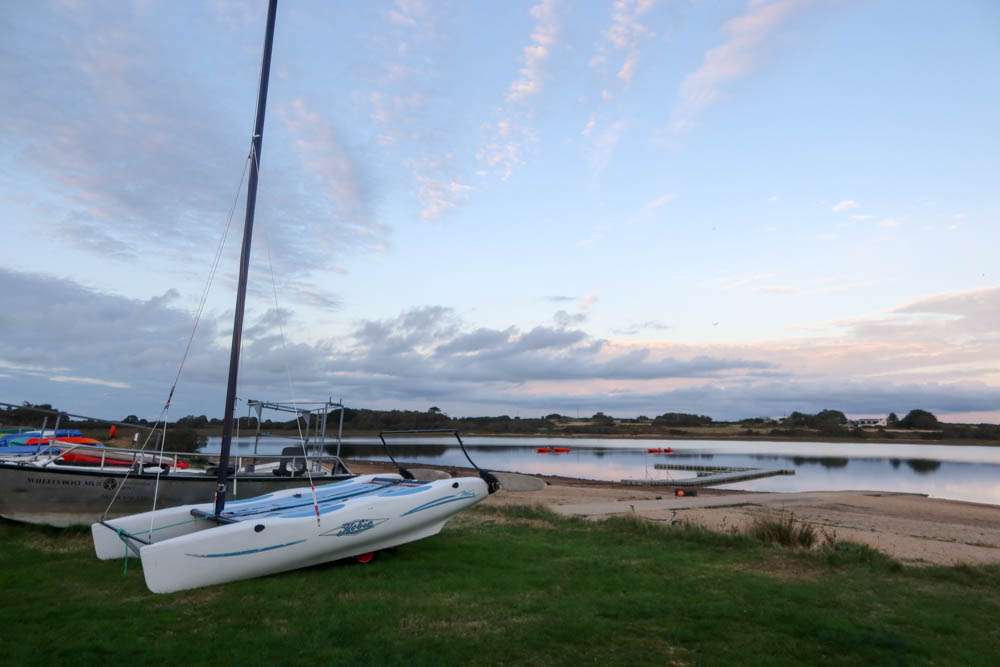
One of my favourite hidden gems in Cornwall, Stithians Lake is a campsite and watersports centre.
We spent about a month here on and off in summer 2021, and loved lazy mornings at the Wild Vibes Cafe followed by a paddleboard session.
You can read my full review of Stithians Lake here.
30. Climb up to Carn Brea
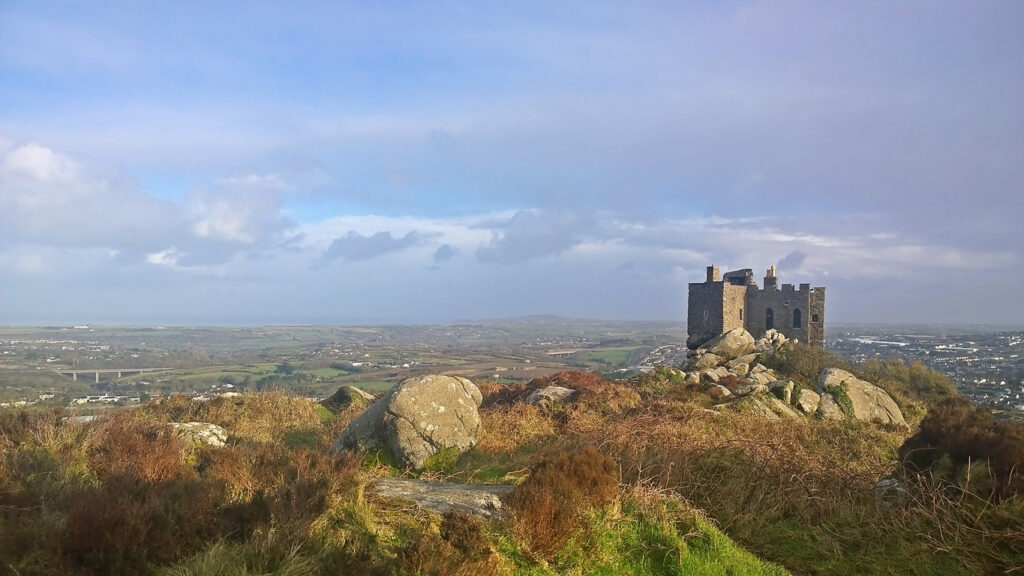
Carn Brea looks out over Redruth. Formerly an Elizabethan hunting lodge, it nowadays houses a restaurant that serves Mediterranean food.
Visit to enjoy the beautiful views over this part of Cornwall, chow down on some delicious food in a unique location or learn about the building’s history.
31. Beach hop around St Ives

St Ives is a quintessential Cornish town; while it’s busy, it remains one of my favourites.
It is home to beaches and plenty of watersports and has some great hiking opportunities.
Taking a train into the town is a spectacle, and the fun only starts there.
The town itself has its own charm, being busy enough to have lots going on but quiet enough to get enough solitude.
Dotted with quirky shops, exciting road names, and Fisherman’s Cottages, it’s a delightful place to get lost in for a day.
For wildlife, take a boat out to Seal Island and see the Atlantic Grey Seals, or visit the privately owned Carbis Bay beach for some solitude.
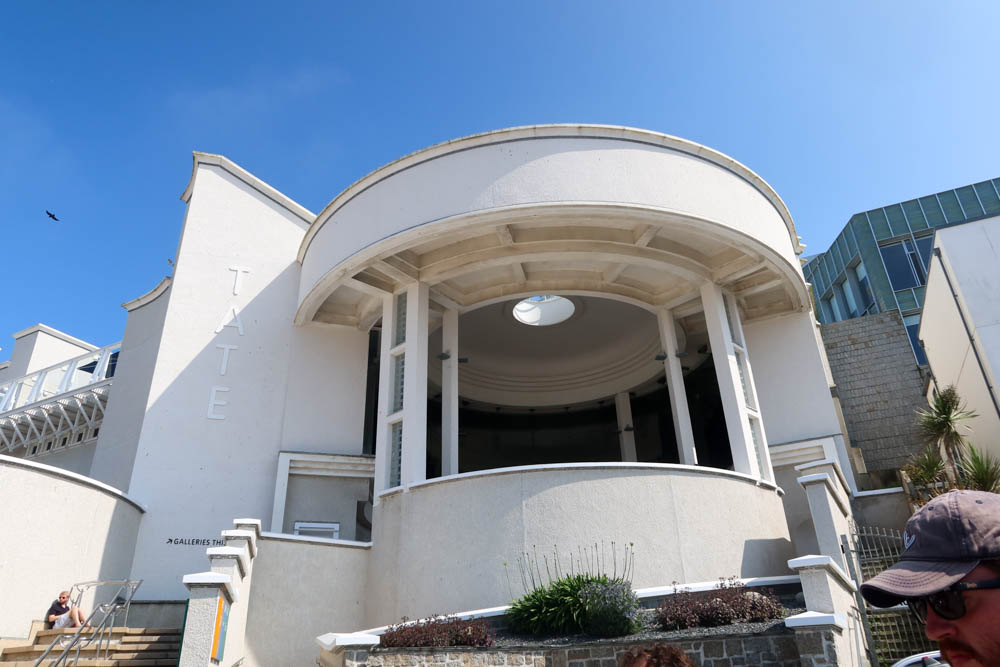
With epic coastal scenes, it’s no surprise that Cornwall has been an artist’s haunt for decades.
The most popular town for artists has historically been St Ives.
Many artists, like Barbara Hepworth, have taken inspiration from the town’s gorgeous scenery.
Nowadays, there are lots of art galleries in town, including the TATE St Ives, which is one of the best things to do in town.
32. Descend into Geevor Tin Mine

The Geevor Tin Mine is one of my favourite things to do near St Ives.
It’s unknown when it dates back to, although there are parts believed to be from the late 18th century.
It was a tin mine throughout Cornwall’s mining heyday, and prospered for well over a century, before it closed for the first time in 1986; although it then opened and reopened again before finally closing its doors!

Situated in the mining landscape of Pendeen, on the rocky coastline of West Cornwall, this mine is a step back in time.
You can explore the mining museum, go underground in a mine or take in the epic scenery from the clifftops.
The best part is The Dry, which was the old offices and changing rooms of the mining staff. They’ve eerily been left as they were in the early 1990s, when the mine closed.
33. Enjoy the Land’s End Attraction

As the name suggests, Land’s End is the terminus of Cornwall. The most southwesterly point of mainland UK, this spot, bashed by tumultuous waves, is where Britain meets its craggy end.
There are quite a lot of things to do in Land’s End, including a 4D cinema, King Arthur Experience and shopping.
However, I love visiting Land’s End to take in its beautiful scenery and hiking a little way to Sennen Cove or Nanjizal Beach. Porthgwarra is another scenic cove that I love that’s close to Land’s End.
34. Stay at the First and Last Inn
The First and Last Inn is located in Sennen and is one of the most atmospheric pubs to stay at in Cornwall.
Due to its western location, it has history of smuggling; it’s allegedly haunted by Annie George who was the landlord’s wife in the 18th century.
Her and her husband refused to pay their rent for the inn and were evicted, and subsequently told the authorities about the town’s smugglers.
It’s alleged that she was murdered on the beach and her body laid to rest in her bedroom, before being buried.
Along with learning about ghosts, you can enjoy some proper pub grub and look down into a smuggler’s tunnel at this charismatic inn.
35. Learn about communications at the Porthcurno Telegraph Museum
While Cornwall isn’t known for being the most connected place in the UK, it once had a telegraph line that meant messages could reach India in nine minutes.
It connected to the rest of the British Empire too, and become the most important telegraph line in the world in the latter Victorian era.
You can learn all about this in the Porthcurno Telegraph Museum, a museum dedicated to the line.
36. Be charmed at the quaint village of Mousehole
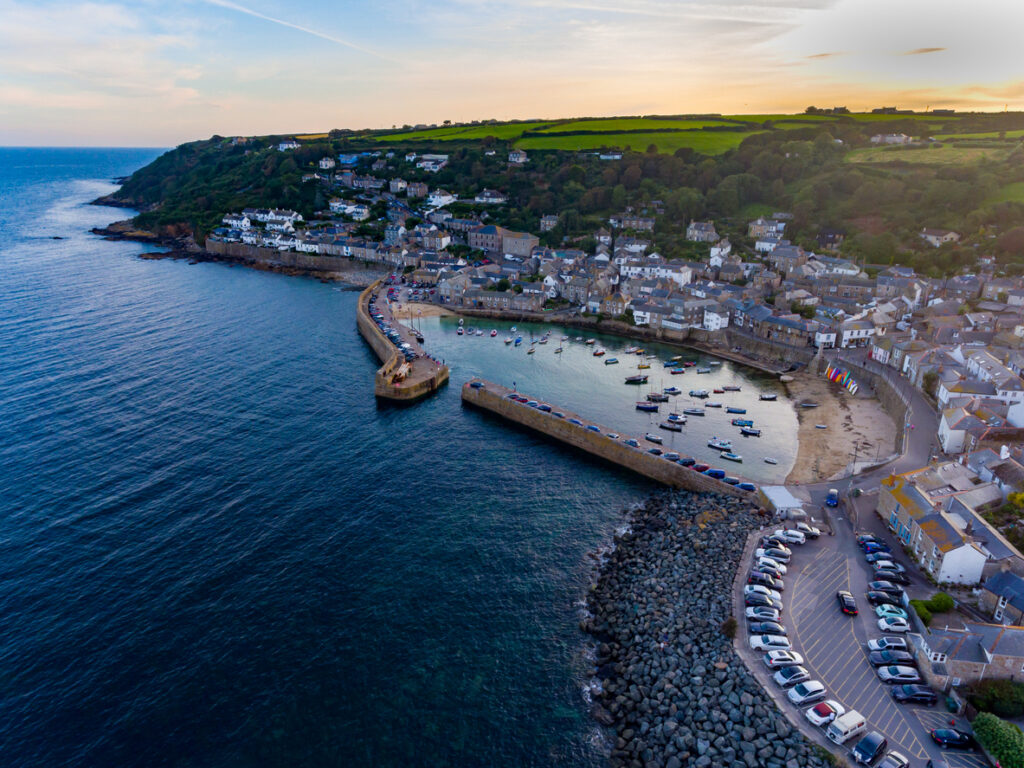
Mousehole is undoubtedly one of the most gorgeous villages in Cornwall – if not the whole of the UK.
In fact, it’s my favourite Cornish fishing village, thanks to the historic fishing cottages and quaint harbour.
Life in Mousehole revolved around the fishing industry for centuries; its fascinating history includes raids by the Spanish, smuggling, cholera epidemics and being one of the last outposts of the Cornish language.
Walking around the charming village is definitely one of the best things to do in Cornwall; check out my Mousehole guide for more information about this incredible village.
37. Walk up Chapel Street in Penzance
Penzance isn’t the most popular town in Cornwall, but I personally love the relaxed atmosphere of the harbour and the sweeping views over Mount’s Bay.
Chapel Street is even more culturally fascinating. Take a stroll down the street and see the Egyptian House which is a Georgian building with North African decor, the Turk’s Head pub which is thought to be the oldest in town and the House of Maria Branwell, who was mother of the Bronte sisters.
It’s one of the most interestingly historical streets in Cornwall and is well worth a stroll down if you want a break from the beaches!
You can either explore Chapel Street independently or do a guided walking tour with Anna, a knowledgeable local who knows the town like the back of her hand. This was one of my favourite things to do in Penzance!
38. Swim at the Penzance Lido
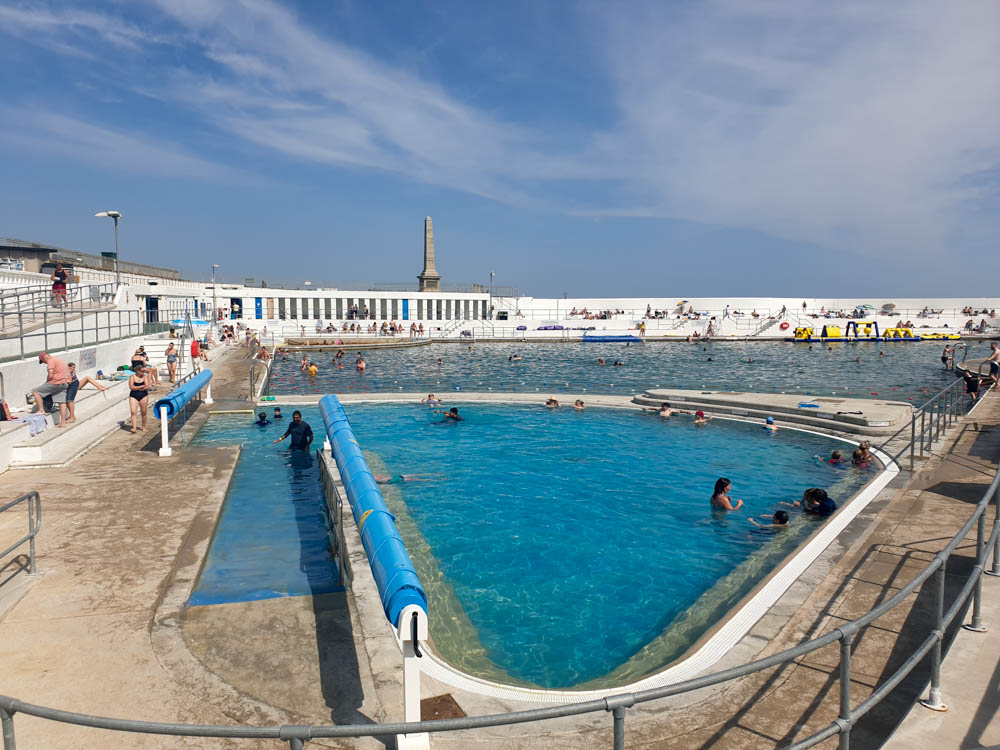
Another attraction I love in Penzance is its lido.
The Penzance Lido, also called Jubilee Pool, is a huge outdoor pool separated into two parts.
One is an open-air art deco seawater pool, which can be chilly but is slightly warmer than the sea, and another is a warmer geothermal pool.
39. Drink at a Meadery
If you want a quintessentially Cornish dining experience, there’s nothing better than heading to a meadery – which, for some reason, only seem to exist in West Cornwall!
There are a few of these restaurants – which are Medieval-themed eateries serving mead and hearty and sizeable portions of breaded mushrooms and chips, vegetarian and beef lasagne and burgers – not the most authentic Medieval food, but they’re certainly filling!
Of course, there’s plenty of mead of different flavours available, and the decor and atmosphere make it an unforgettable dining experience.
40. Be wowed at Kynance Cove
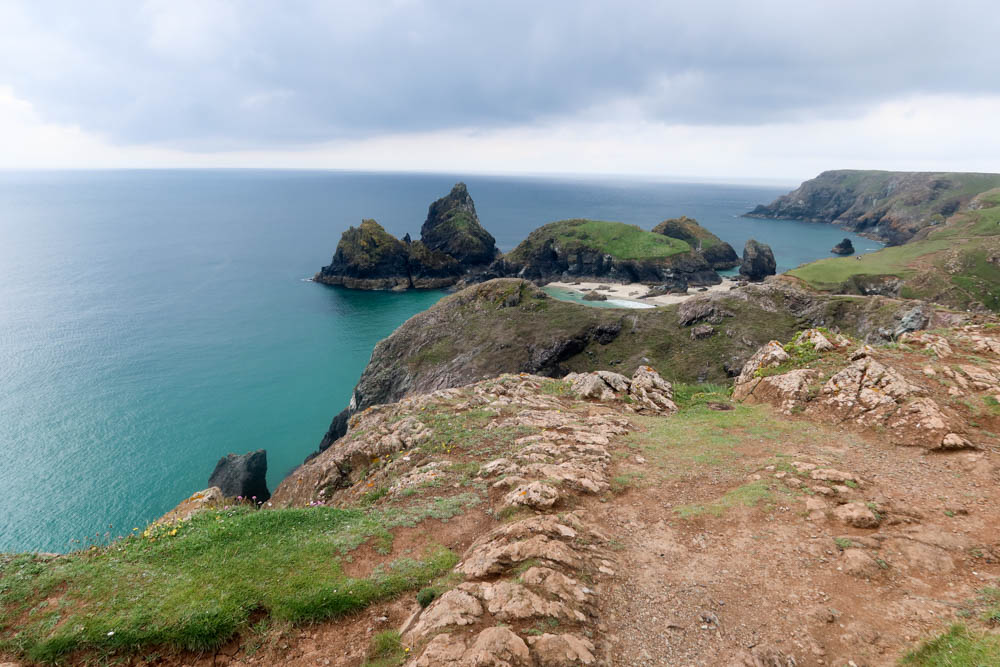
The beautiful beach of Kynance Cove is without a doubt one of the best things to do in Cornwall.
Sitting not too far from Lizard Point, the rocky beach consists of patches of sand with gaps in the rocks leading the way to bright blue water.
My favourite part of Kynance Cove is actually the trail above where you can take in the spectacular birds eye view of the entire beach.
There’s a small cafe above where you can enjoy a Cornish cider from Polgoon winery near Penzance and take in the view!
41. Head to Lizard Point, the furthest south point in the UK
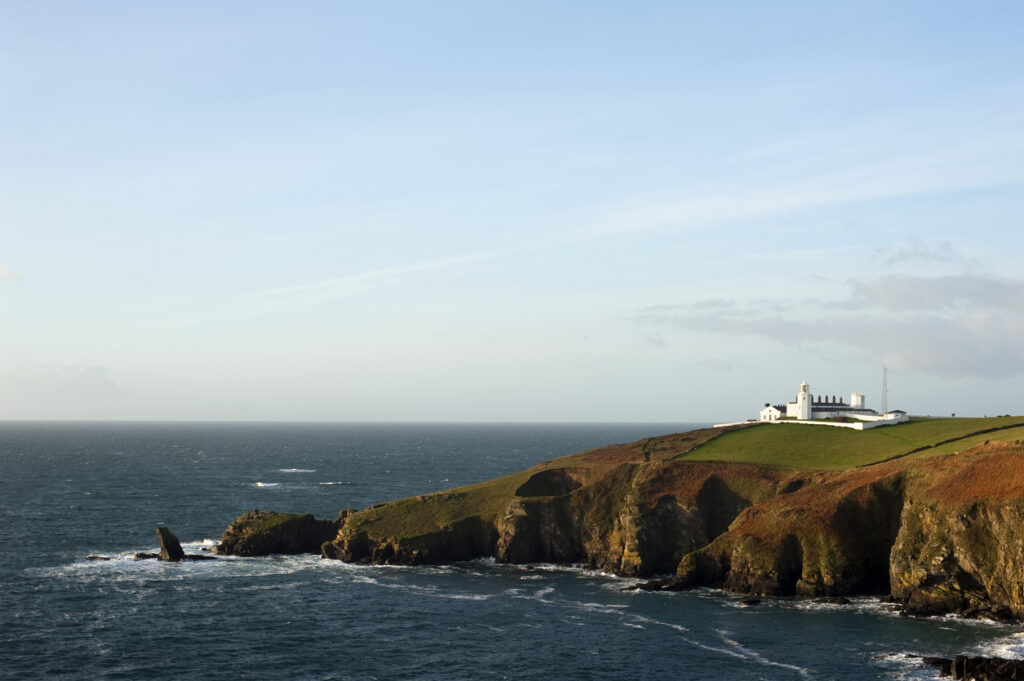
While Land’s End is rather commercial, Lizard Point is another “end” of Cornwall that’s quieter.
Here, there’s the southernmost cafe in the world – but the best part is the craggy views from the southernmost point in mainland UK.
Take a stroll on the South West Coast Path (you can walk all the way to Kynance Cove), or amble to Lizard village, where you can enjoy a beer at the southernmost pub in the UK.
This is actually a hotly contested title, with The Witchball and The Top House Inn claiming the title – so drink at both if you want to be really sure you’ve ticked this off your Cornwall bucket list.
42. Road trip around the Lizard Peninsula
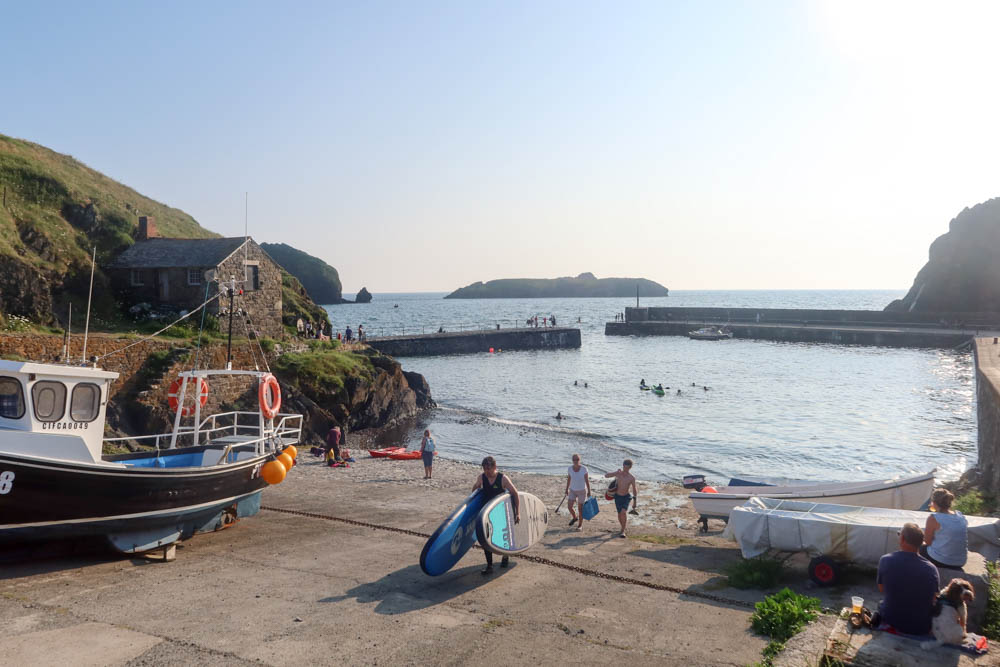
It’s time for a road trip!
I love a road trip around Cornwall, but if you only have time for a shorter trip, why not just drive around the Lizard’s highlights?
Some of the best things to do on the Lizard Peninsula include:
- Poldhu Cove: A beautiful alternative to Kynance Cove if it’s too busy.
- Gunwalloe Church Cove: A sweeping beach with a church.
- Cadgwith Cove: A charming fishing village that doesn’t see as much tourism as the other villages in Cornwall.
- Coverack: A beautiful village with bright-coloured boats.
- Roskilly’s Farm: A charming ice cream farm.
- St Keverne: An inland village that was famous in the Cornwall uprisings.
- Mullion Cove: A popular spot for watersports like stand up paddleboarding.
Also, don’t miss the Gweek Seal Sanctuary, Kynance Cove and Lizard Point, along with Lizard’s other beaches.
43. Go coasteering on the Lizard

Coasteering is exploring Cornwall’s coastline by climbing, clambering and swimming.
There are a few coasteering tours in Cornwall, but Lizard Point is one of the best spots for it in the country.
You can book tours with Lizard Adventure; they also do SUP and rock climbing excursions around the peninsula.
44. Take a boat from St Ives to Seal Island
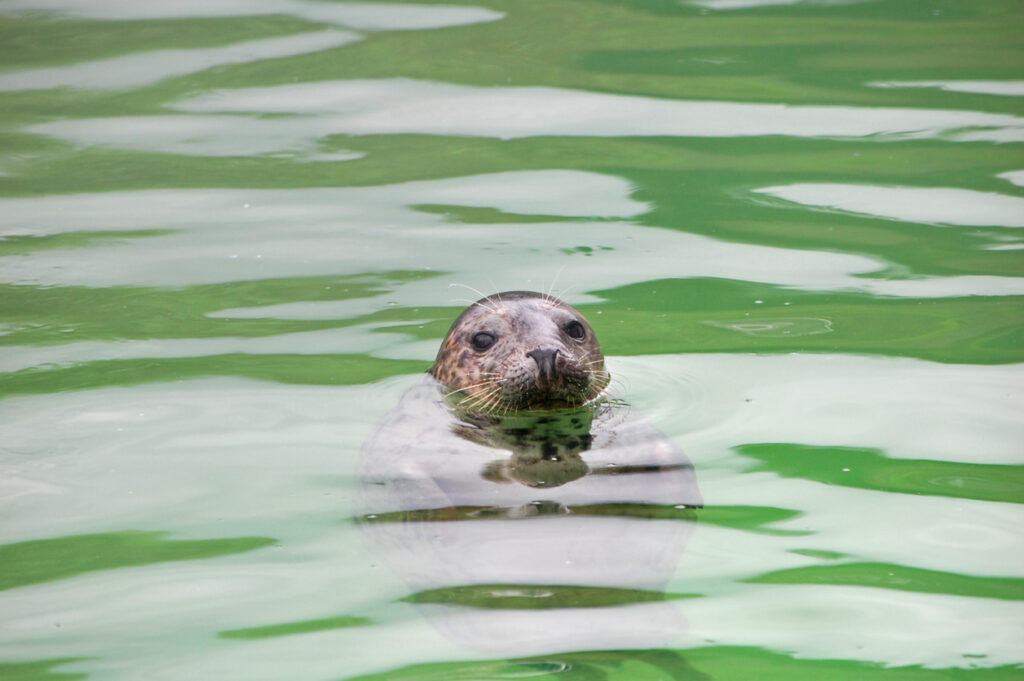
One of the best things to do in St Ives is to take a boat out to the rocky Seal Island.
As you may be able to guess by the name, this is one of the best places to see seals in Cornwall.
The island is home to a colony of Atlantic gray seals; you’ll usually spot them on a boat trip to the island. There’s also a shipwreck close to the shore.
Boat trips to Seal Island don’t include a stop off at the island but they incorporate sailing there and spending some time looking at the gorgeous Cornish creatures.
45. Visit Chysauster, an ancient Cornish village
One of the best things to do in Cornwall for history lovers, Chysauster is a Romano-British settlement that dates back two millennia.
The ancient village contains unique architecture that’s only been found in far West Cornwall and the Isles of Scilly.
Take in the rocky remains of the village and even descend into a fogou. These are found all over Cornwall; they were underground caverns that were potentially used for storage.
46. Cape Cornwall

People used to believe that Cape Cornwall was the furthest west point of England; nowadays, it’s known that Land’s End is the furthest South West.
While Cape Cornwall used to be incredibly popular, it’s nowadays a complete Cornish hidden gem, barely seen by most tourists to Cornwall.
Enjoy dramatic craggy scenery and take in the tin mine ruins on the promontory.
47. Visit the Museum of Cornish Life in Helston
The Museum of Cornish Life is one of the best free things to do in Cornwall.
Focusing on Cornish life through the ages, here you can see historic toys, farming equipment and historic storefront displays.
It gives a valuable snapshot of Cornwall in centuries gone and is completely free of charge.
There are a few other things to do in Helston too!
48. Go to the Gweek Seal Sanctuary

If you want to be guaranteed to see seals in Cornwall, head to the adorable Gweek Seal Sanctuary.
We visited this attraction on an afternoon thick with Cornish mizzle (mist and drizzle), and it definitely put a smile on our faces after an otherwise damp day!
The seal sanctuary rescues and rehabilitates injured and orphaned seals which are found around the Cornish and Devon coastline.
They aim to release all seals once they are strong enough to survive back in the wild.
Sadly, the nature of some of their injuries means that they will never survive in the crashing Atlantic Ocean; in these instances, the sanctuary offers them a permanent home.
By visiting the sanctuary, you’re contributing to the vital work that they do here to protect and conserve the population of Cornish seals.
49. Walk around Trebah Gardens
The subtropical gardens of Trebah are reminiscent of sunnier, warmer climates; if you want to feel like you’re abroad, this is the place in Cornwall to visit!
With its own private beach and mass of plants from Mediterranean countries and the Southern Hemisphere.
The gardens change seasonally, with rhododendrons, magnolias, and camellias from 100 years coming out in Spring, a giant gunnera in Summer, Hydrangeas in Autumn, and champion trees in winter.
50. Hike Brown Willy on Bodmin Moor

Cornwall doesn’t just do beaches; it has stunning moorland as well. Bodmin Moor is a 200 square metre area of grassland.
On the site are delightful granite outcrops and heather patches, and it’s the perfect place for a stroll.
Check out the ancient stones, like The Cheesewring and The Hurlers, and look for the Cornish Path Moss – which is the only place in the world where this type of moss grows.
Poldark fans definitely need to visit this area – many of the scenes of the characters on horseback and the outside of Ross Poldark’s cottage were shot here.
The Copper Trail, which is a 60 mile circular walk, starts at the village of Minions. Even if you don’t fancy a 60 mile hike, Minions is a great place to start walking.
Here’s some more advice about hiking on Bodmin Moor
51. Hike up Rough Tor on Bodmin Moor
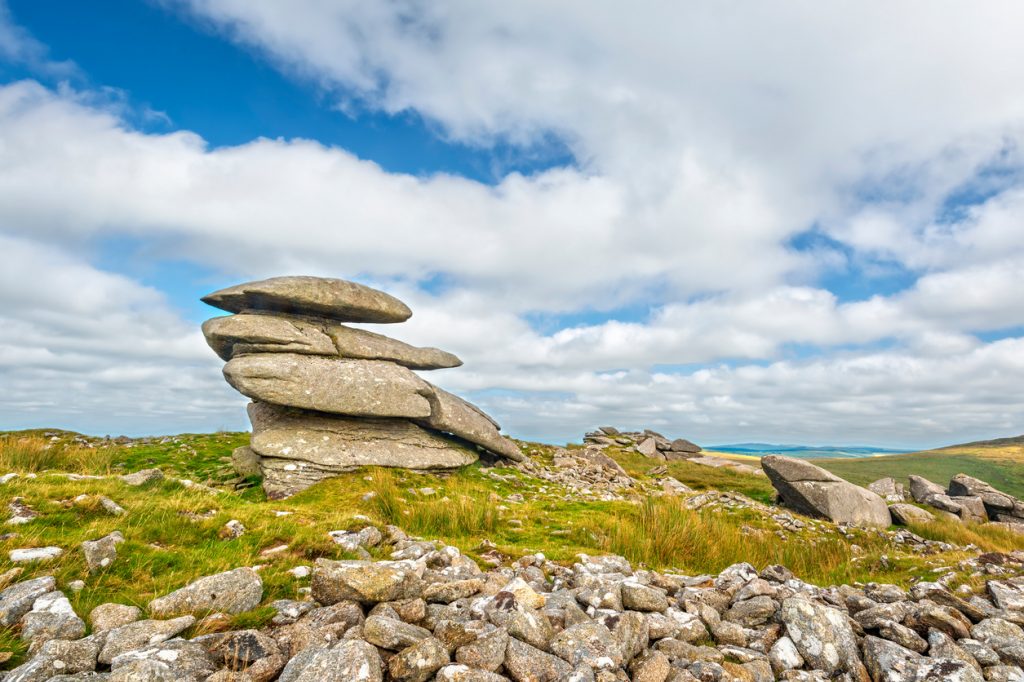
Rough Tor is one of the most iconic landmarks of Bodmin Moor; and while it’s not the highest peak in Cornwall, it’s a close second to Brown Willy!
You can climb all the way to the top of Rough Tor for views of Bodmin Moor’s unique landscape.
In fact, there’s a circular walk that summits up Brown Willy and Rough Tor.
While this route involves two uphill treks, it’s possibly the best way to take in the fantastic scenery of Cornwall’s interior.
52. Stay Overnight in Jamaica Inn
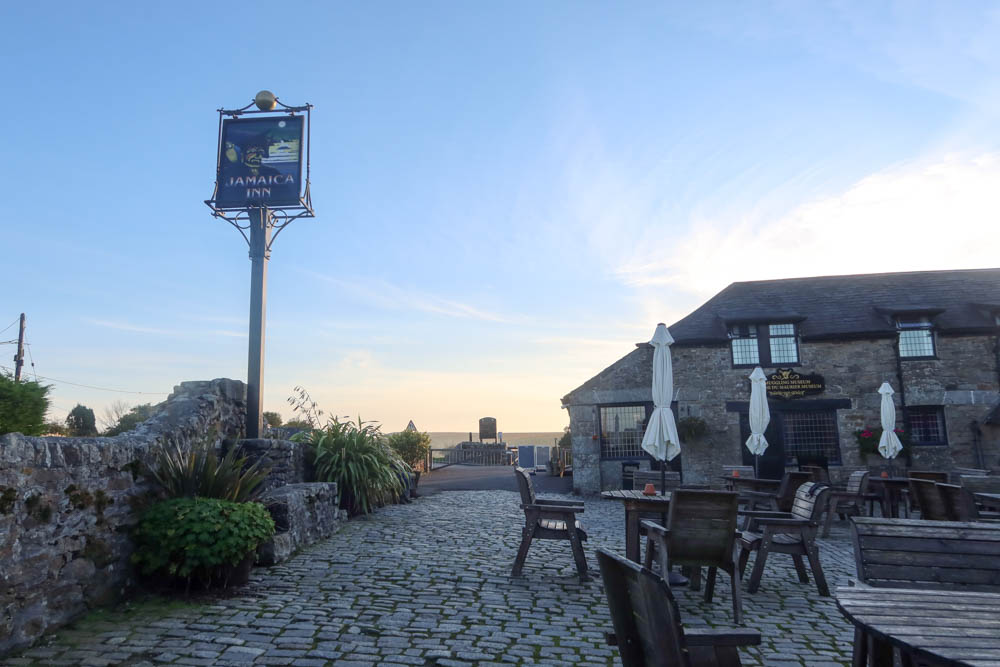
I’ve stayed in hotels, guesthouses and caravan parks all over Cornwall, and Jamaica Inn is probably my favourite.
This eerie inn, which sits in the middle of Bodmin Moor, was once a coaching house and smuggler’s hideaway.
Due to its remote location, it was a place to store contraband when the smuggling trade was rife in Cornwall.
It gained global fame in 20th century when Daphne Du Maurier stumbled upon the inn after getting lost on Bodmin Moor.
She found the tales of smugglers at the inn fascinating, and subsequently wrote her famous book of the same name!
Nowadays, Jamaica Inn is home to a cosy smuggler’s themed restaurant, a smuggling and Daphne Du Maurier Museum, a farm shop, a gift shop and local walks.
You can also stay in the smuggler’s inn – and while the rooms encompass historic features, they’re luxurious and incredibly comfortable.
53. Visit the eerie Bodmin Jail
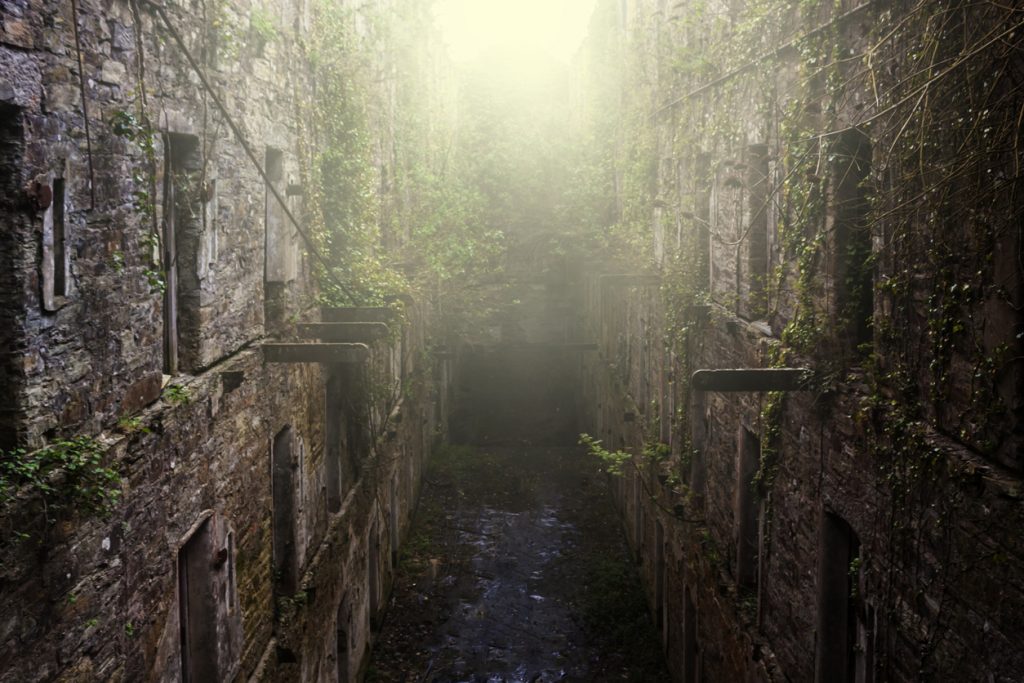
The creaky Bodmin Jail isn’t the attraction that most people associate with Cornwall; but it’s actually one of my favourite things to do in the region, especially if it’s raining.
Dating back to the late 18th century when it was built from Delank granite, Bodmin Jail nowadays looks very foreboding. However, for its time (pre-Victorian era), it was actually very modern.
It was one of the first British jails to have exercise areas, male and female dormitories and hot water. Our tour guide told us that it was largely thanks to Bodmin Jail that prisoners started to be treated with a little more compassion.
However, it was still a prison, and crime and punishment in the 19th century was very different from how it is today.
On a self-guided or guided tour, you’ll walk through the cinematic animations which give a snapshot of what life was like in historic Cornwall, and some of the crimes that people could go to jail for.
These varied wildly, from petty theft to arsenic poisoning – to others being framed for crimes that they didn’t commit.
You can explore Bodmin Jail independently, but I highly recommend a guided tour.
Your guide will bring the history of the establishment to life and invite you to contemplate many ethical dilemmas surrounding crime and punishment.
Check out the other things to do in Bodmin here.
54. Admire the stately home of Lanhydrock House
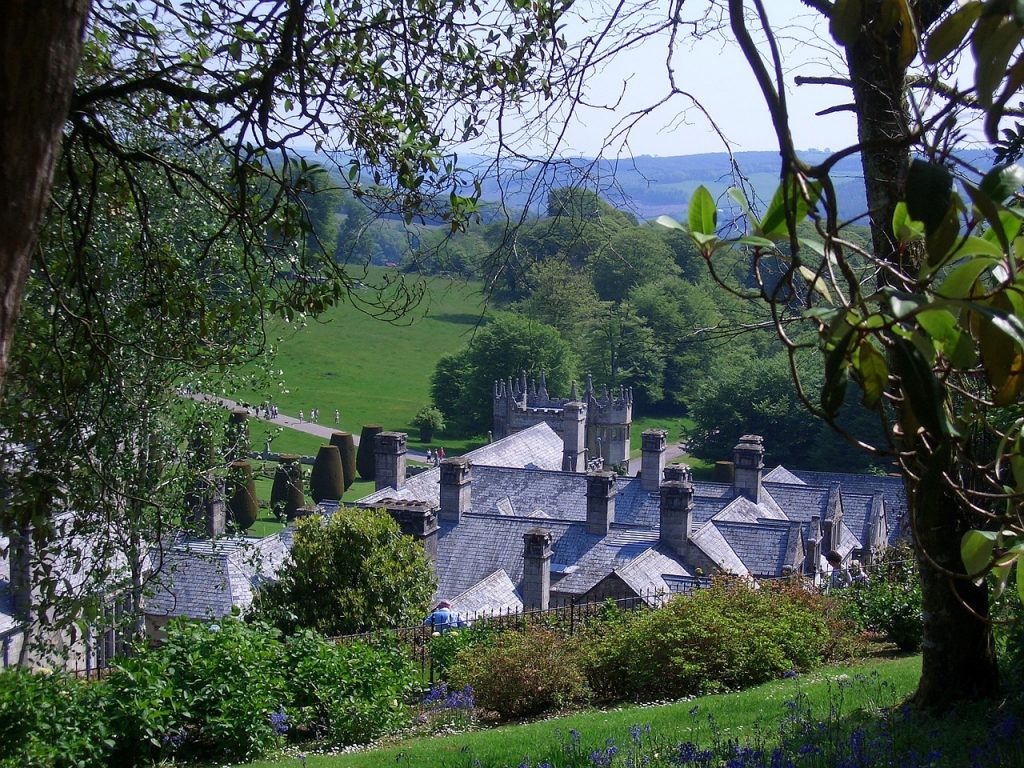
Sitting outside of Bodmin, Lanhydrock is one of Cornwall’s main country houses. Parts of it are Jacobean, but most of the house was rebuilt following a fire in Victorian times.
It’s a National Trust-owned property (free entry if you have a National Trust membership – you can check out my full review here).
Explore the rooms of the Robartes family, check out the kitchens which are tailored to look how they did when Victorian servants worked in them, take a stroll through the landscaped gardens or go on a wider hike through the estate.
55. Learn about Cornwall’s religion at Truro Cathedral
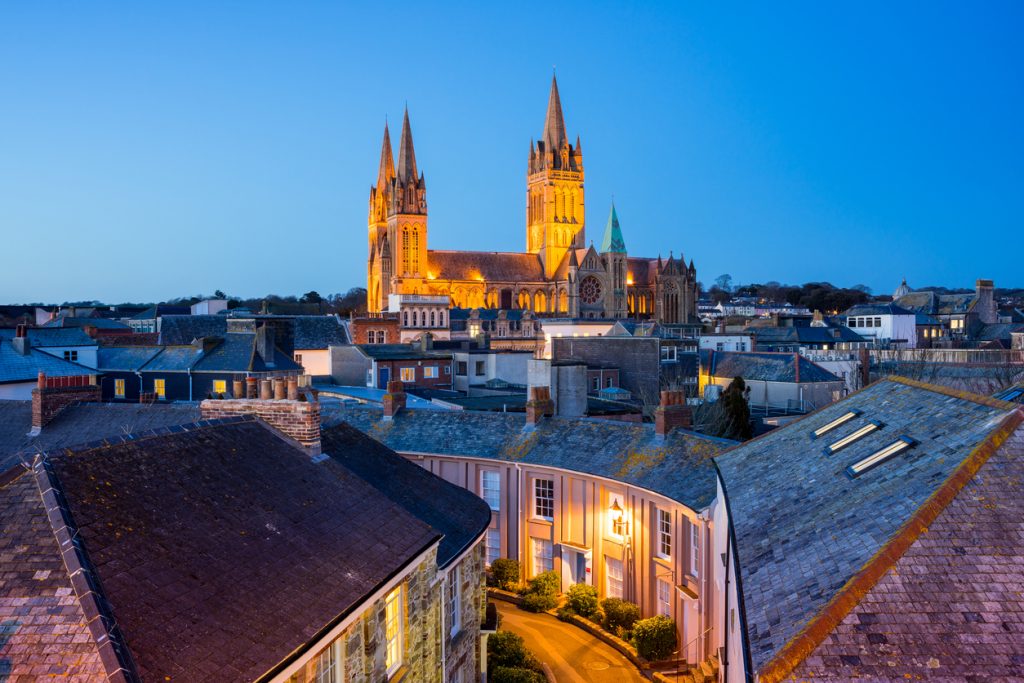
There’s only one cathedral in Cornwall; sitting at the heart of Cornwall’s only city, Truro Cathedral dates back about 140 years and is famous for being one of the only cathedrals in the country with three spires!
While Truro doesn’t have the same religious history as West Country cities like Exeter and Bath, the cathedral still provides a fascinating snapshot of life and worship in Cornwall through the ages.
Plus, Truro Cathedral is one of the best free things to do in Cornwall – that’s right, entry is purely on a donation basis!
56. Educate yourself in Cornish culture in the Royal Cornwall Museum

If learning about local heritage and culture is at the top of your Cornwall bucket list, you should head straight to the Royal Cornwall Museum in Truro.
As a Cornish person, this museum fills me with great pride toward my ancestors.
It’s a fantastic exhibition detailing the Duchy’s fights for independence throughout the years, the reason why it has its own language and own culture and what makes it different to other counties in England.
If you’re looking for rainy day activities in Cornwall, there’s nowhere better than this excellent museum.
Take a look at the best things to do in Truro here.
57. Climb to the top of Launceston Castle

Despite the fact that the A30 nearly runs through the town, Launceston isn’t exactly a tourist hub.
From the town centre, it’s walking distance to the Tamar and Devon (in fact, Horsebridge, one of the historic crossing points of the Tamar, is just out of town).
However, it’s a place of immense history and culture.
I was lucky enough to have a walking tour from the town crier, Rob Tremaine, who showed me around the town and helped me write this things to do in Launceston post.
58 – 66. Visit the Isles of Scilly
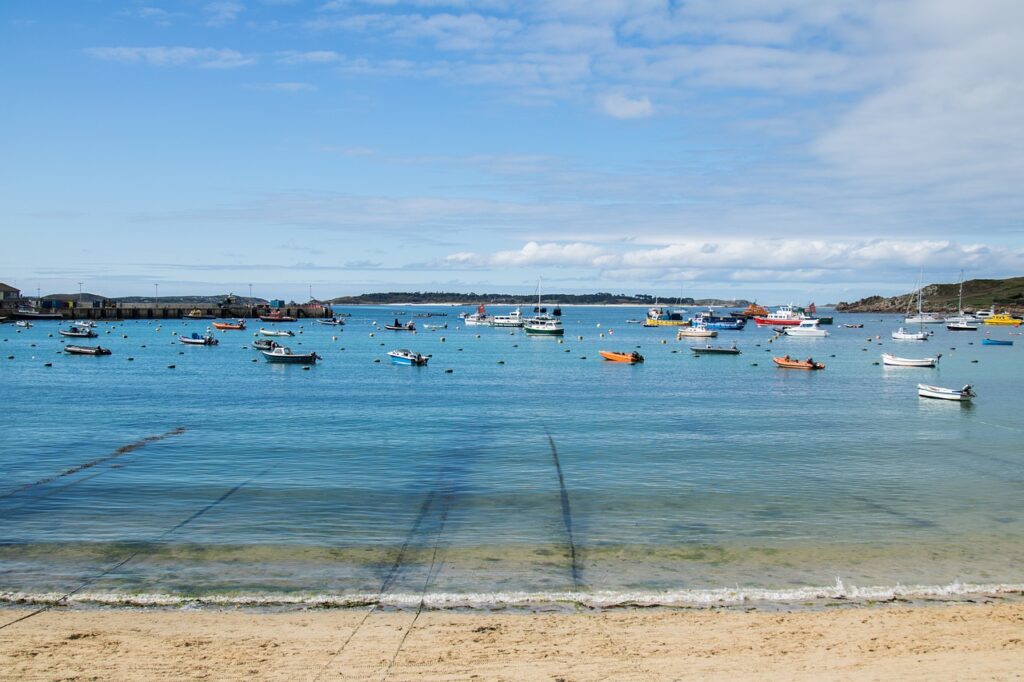
Sitting South West of the tip of Cornwall, the Isles of Scilly are a world unto themselves.
They are stunningly beautiful, with their very own microclimate giving them a unique, subtropical feel that cannot be found anywhere else in the country.
Enjoy some of the country’s best beaches, swim in blue waters, and relax into tranquil island life by taking a Cornish staycation to the Isles of Scilly; you can fly there from Exeter, Newquay, or Lands End, or take a boat from Penzance Harbour.

Here are some of the best things to do on the Isles of Scilly:
- Tresco Abbey Garden: These subtropical gardens boast 20,000 plants from over 80 countries and are ideal for a summertime stroll.
- Garrison Walls: Sitting on St Mary’s, close to Hugh Town, Garrison Walls date back 350 years and are one of the most impressive coastal defence systems in the country.
- Ride in a Scilly Cart: As there are very few cars on the islands, many tourists hire carts to travel around the island.
- St Mary’s Open Air Cinema: Enjoy long summer evenings by taking in a film in gorgeous surroundings at St Mary’s.
- Watersports: As the islands are so water-focused; they’re known as the “UK’s tropical islands”, it’s no surprise that there are plenty of watersports, from kayaking to stand up paddleboarding, to enjoy!
- Cromwell’s Castle Tresco: Built in 1651 after the Scillies were conquested by the royalists after the civil war, this castle is one of the last Cromwellian castles in the country.
- Visit the Isles of Scilly Museum: The Isles of Scilly Museum, situated in Hugh Town which is the archipelago’s main town, details the history and culture of this unique land.
- Go on a nature boat tour: Seaquest Scilly run boat trips around the islands where you can look out for dolphins, seals, puffins and countless other animals.

67. Take a surf lesson
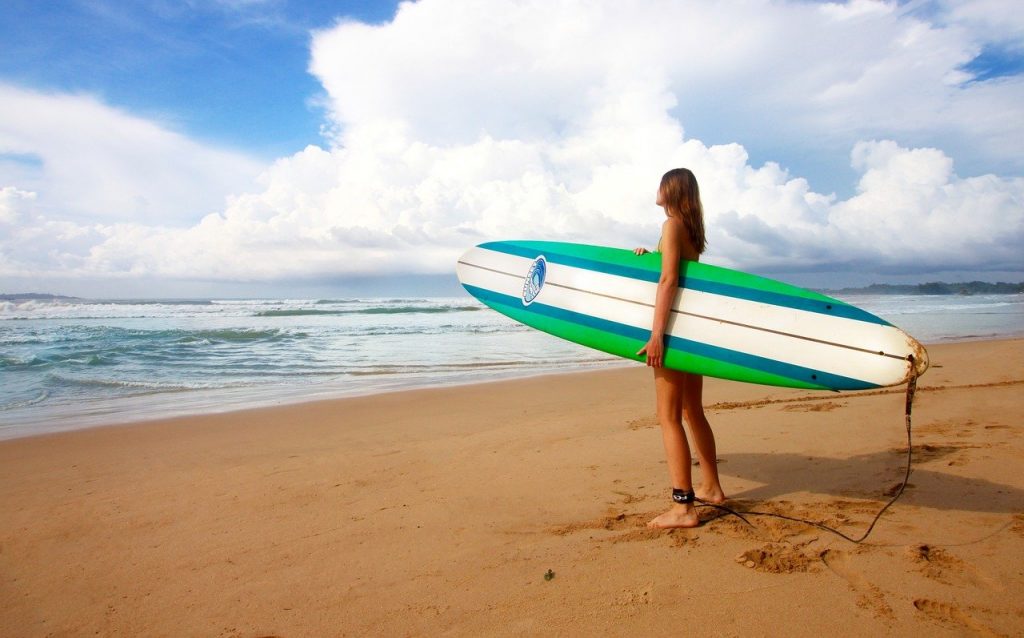
Surfing is one of the best activities in Cornwall, and there are plenty of places where you can do it!
Thanks to Cornwall’s peninsular position – it’s not sheltered at all by any land masses along its Atlantic Coast – it is one of the best destinations for surfing in Europe.
If you want to try your hand at surfing, head to Fistral Beach in Newquay, Perranporth Beach in Perranporth, Porthmeor Beach in St Ives, Widemouth Bay in Bude or Polzeath Beach in Polzeath.
The Cornish destination with the best surfing infrastructure is Newquay.
68. Hike some of the South West Coast Path
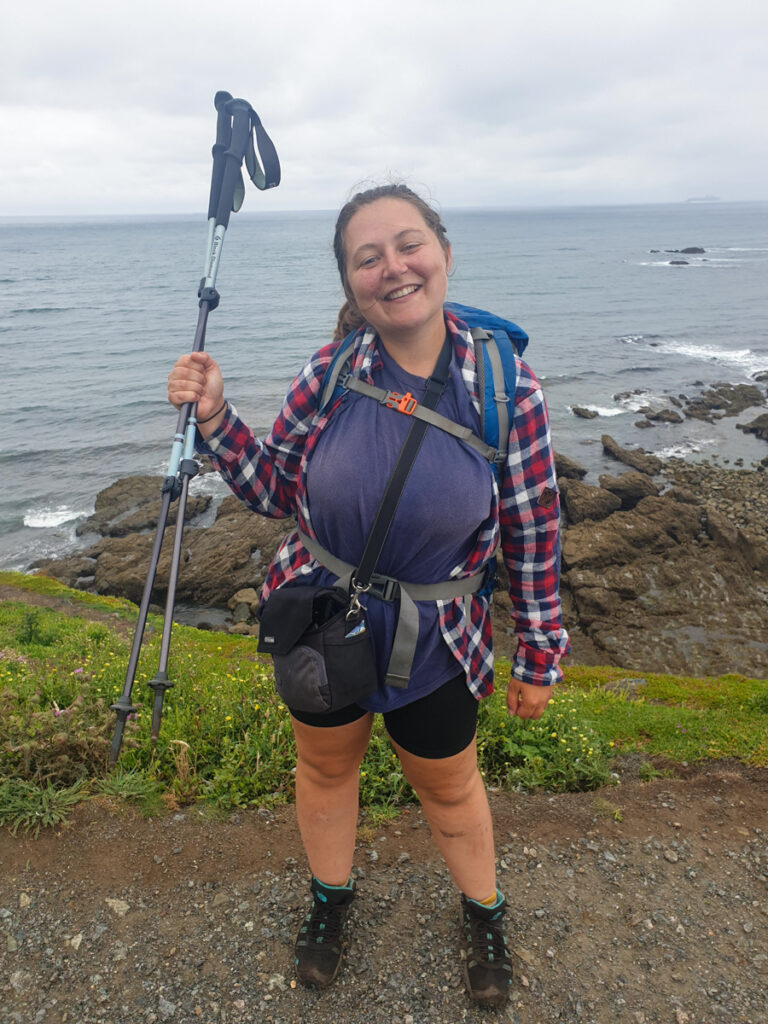
The South West Coast Path stretches along the entire north and south coast of Cornwall, beginning near Morewenstow in the north and terminating by Mount Edgecumbe, where you can take a ferry over to Plymouth.
The 330 miles of Cornish coast path is home to plenty of epic hikes. I’ve hiked it all, and some of my favourites are:
- Hartland Quay to Bude (this technically starts in Devon, but it’s one of the most beautiful – and most challenging – hikes in the region, so I had to include it!)
- Porthcothan to Newquay
- St Ives to Zennor
- around Lizard Point
- Looe to Polperro
Check out my full guide to hiking in Cornwall here.
69. Eat proper pasty!

You might think that you’ve had a proper Cornish pasty before.
But as someone with a very fiercely Cornish family, trust me that until you’ve been to Cornwall and eaten a proper pasty, made by a Cornish person, then you haven’t!
My Cornish grandmother used to make a mean pasty (although she wasn’t impressed when I went vegetarian and asked for it without the beef!).
You can get Cornish pasties at pretty much every bakery in the region; and Greggs is basically a swear word here (although you will find a Greggs at Bodmin services and there’s a new one in Truro, much to my Cornish family’s dismay!).
70. Try a Cornish cream tea
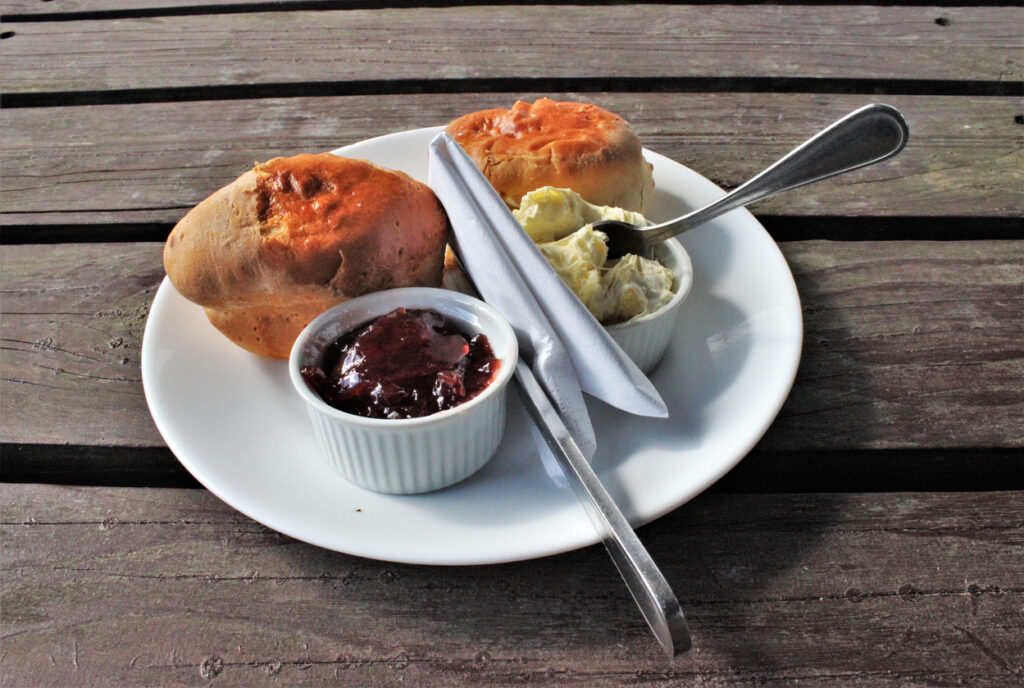
Another must-try, while you’re in Cornwall, is a Cornish cream tea.
This consists of a scone, cut into two, and smeared with jam and cream.
In Cornwall, the jam is spread onto the scone first, and the cream follows.
In Devon, the cream goes first – so make sure that you do it right depending on what side of the Tamar you’re on! (I live in Devon but am part-Cornish, so I never have any idea on how to make my scones!).
71. Go camping
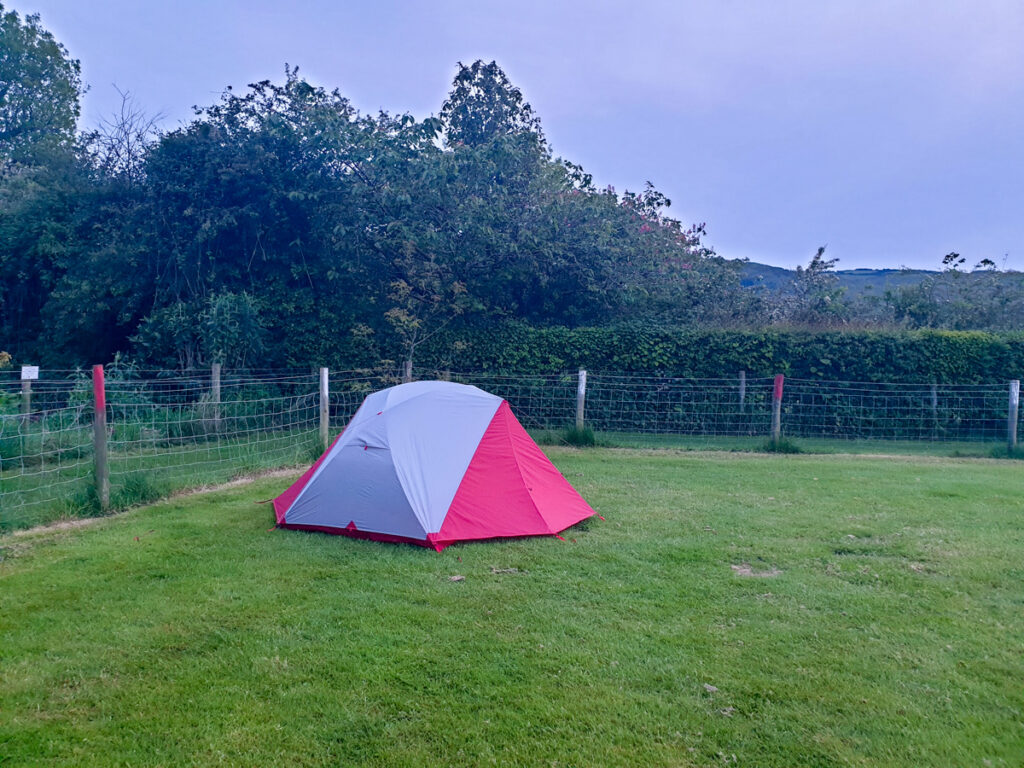
While there are some beautiful luxury hotels in Cornwall, I think that there’s no better experience than putting a fabric home up and sleeping in the region’s gorgeous countryside.
Camping in Cornwall is a must-do experience if you want to get in touch with nature.
75. Learn about Cornish culture
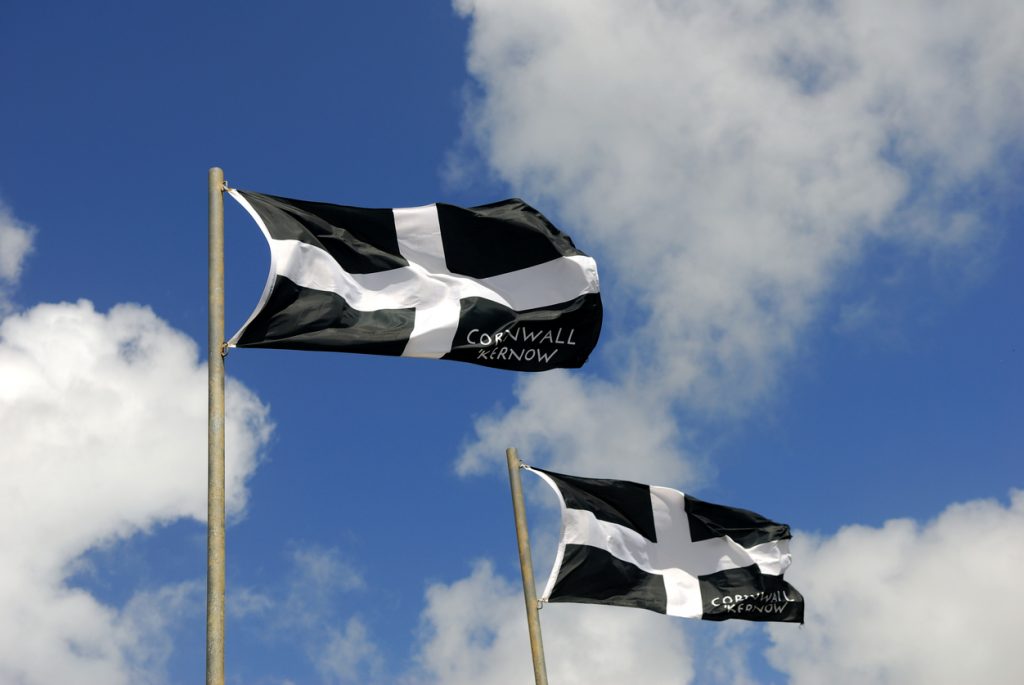
I’ve mentioned Cornwall’s unique heritage a few times in this blog post, and I’d really implore anyone reading this to spend some time learning about Cornish culture and identity while you’re here.
As someone with Cornish ancestry going back to the 13th century, it’s something I’ve become fascinated with over the years; but I think it’s really interesting to any traveller too.
You see, Cornish people are Celtic; not Anglo-Saxon.
They were cut off from England for such a long time due to their physical distance and the geography of the land (thanks to the rugged coastline and Bodmin Moor!), which caused unique cultures, celebrations, saints and even a language to prosper.
Although Cornwall was ultimately anglicized, its spirit never died. You can see it in Cornwall’s many festivals, in the place names, in the black and white flag and in the passion of the people.
Spend some time learning a little more about what makes Cornwall different when you’re here; I promise it’ll be one of the most rewarding things that you do.
How to experience Cornwall’s best attractions
Cornwall’s not a big place. Theoretically, you could get from east to west in a two hour drive – but there’s often traffic!
It’s highly unlikely that you’ll be able to squeeze in all of these top Cornish attractions on your visit there, so here are my best tips for ensuring you see the ones that mean the most to you!
Explore one area at a time
To avoid spending all your time in the car, I’d recommend exploring one area of Cornwall at a time. Here are some top attractions in each area:
- North East Cornwall: Tintagel Castle, Boscastle Harbour, the beaches of Bude, the charming village of Port Isaac and Padstow’s restaurants.
- North Cornwall: Newquay, Bodmin Moor, Perranporth, St Agnes, Portreath
- West Cornwall: St Ives, Mousehole, Land’s End, the Minack Theatre, the Lizard (for Kynance Cove, Lizard Point and Gweek Seal Sanctuary), St Michael’s Mount.
- Isles of Scilly: You can take a boat from Penzance or a plane from Newquay airport to reach the Scillies and enjoy attractions like Tresco Abbey Gardens, the Garrison Walls and riding in a Scilly Cart.
- South Cornwall: Truro (for the Cathedral and Royal Cornwall Museum), Falmouth (for Pendennis Castle and the National Maritime Museum) the Eden Project, the Lost Gardens of Heligan, the Fowey Estuary and parts of Bodmin Moor.
- South East Cornwall: The Tamar Valley, Rame Peninsula, town of Launceston, the beautiful village of Polperro and the Looe Estuary.
Pick one or two specific attractions in other areas of Cornwall
If there are attractions in other parts of Cornwall that you can’t miss, I’d advise picking one or two only and driving there early in the morning to avoid crowds (this is especially prudent if you’re visiting Cornwall in summer!).
Stay centrally
If you do want to see a few attractions in west and east Cornwall, stay somewhere like Newquay; its central location means that you won’t need to drive too far in either direction.
Visit off-season
I’m always advising people avoid visiting Cornwall in the busy summer months. In the autumn, winter and spring, you’ll encounter less traffic, which means that you’ll be able to see more in a less stressful way!
Less is sometimes more
Don’t forget to factor in time chilling out, enjoying the scenery and relaxing – you’re on holiday after all! Don’t try to pack too many of these Cornwall attractions and activities into your stay – choose the ones that are close to your accommodation or that are most interesting to you, and remember you can always visit again – once you see Cornwall once, you’ll be plotting your return anyway.
All of the best things to do in Cornwall!
That wraps up this massive post on the best things to do in Cornwall!
From lazing on its beaches, to learning about its history, to engaging in its unique culture, there’s so much to do in this part of the UK.
As I know this region like the back of my hand, I have countless guides bursting of tips and tricks to make the most of your holiday to Cornwall – check out my Cornwall travel guide to begin!
If you have any questions about Cornwall or South West England, drop me a message on Instagram – I’m always happy to help!

